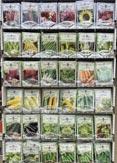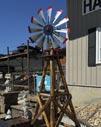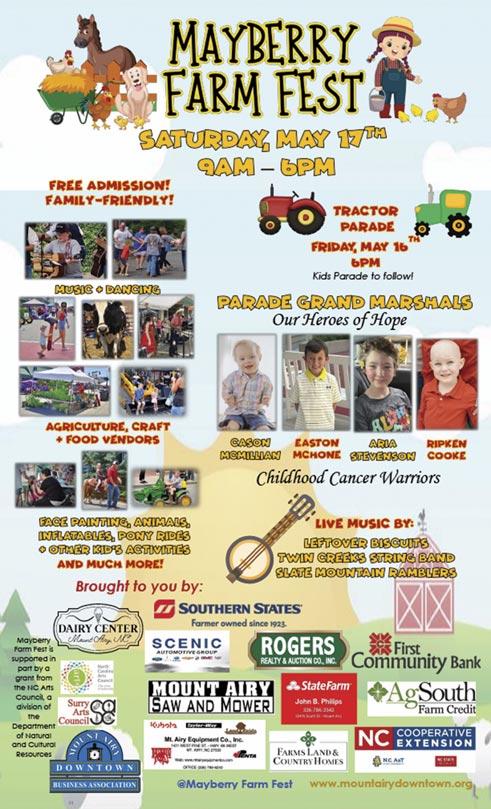May-June 2025


May-June 2025









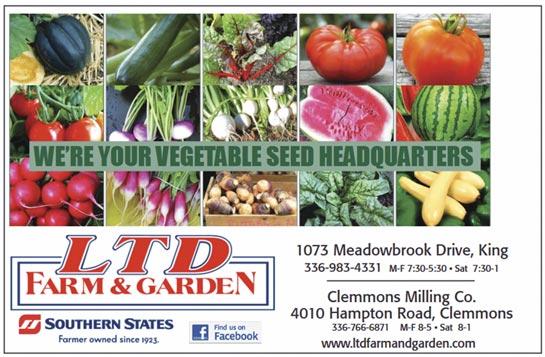


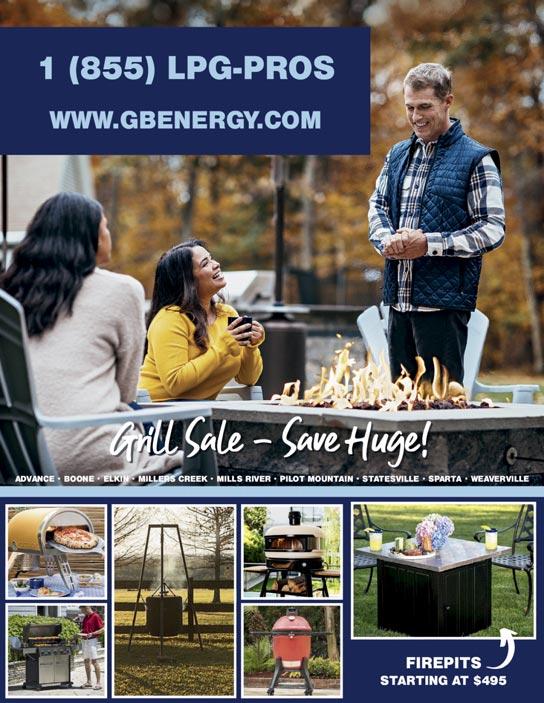



Outdoor Furniture to enjoy for every season of the year, plus Quality Furniture for every room of your home.
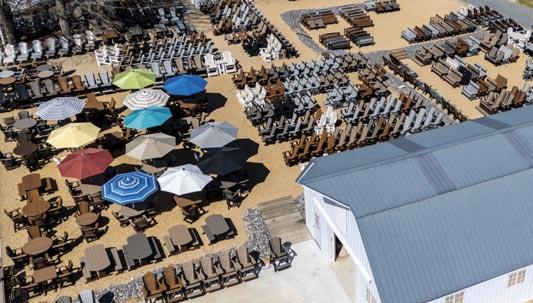
We regret to inform you that we must cancel our Annual Fish Fry “due to unforeseen circumstances” scheduled for June 7, 2025. We understand that this may be disappointing news, and Home Acres Fine Furniture, LLC, the Miller family, and the Union Grove Amish community apologize for any inconvenience this may cause. We would like to thank each of you for your past support, benefitting families in need, and Buck Shoals Volunteer Fire Department, Inc. Thank you again for your understanding.

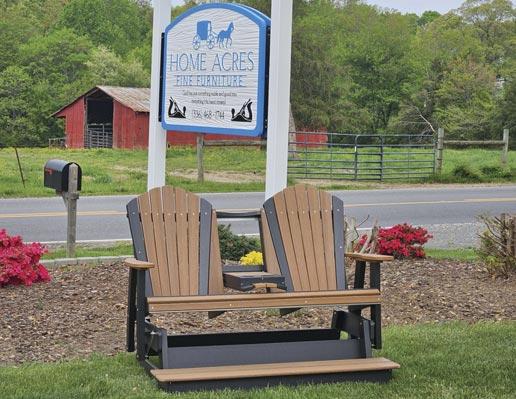






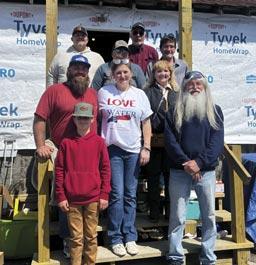
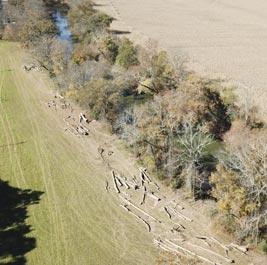
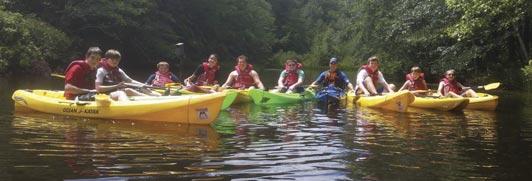



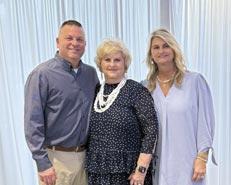




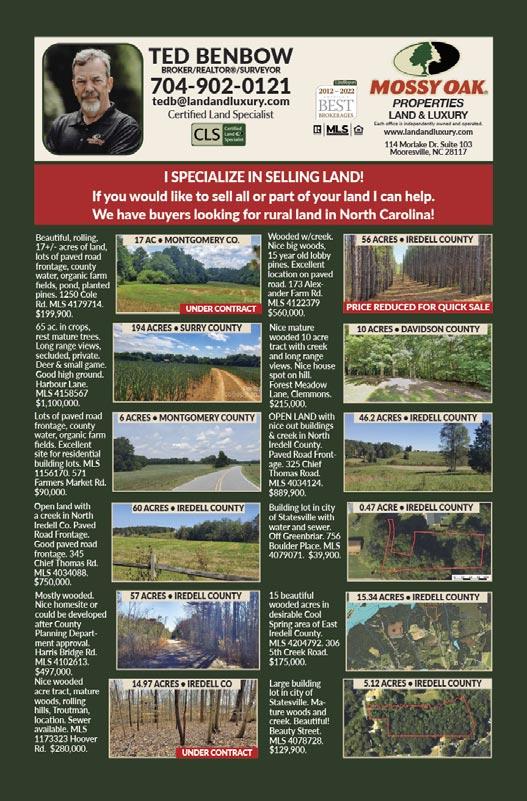

Anyone can provide advice. At Edward Jones, our goal is to provide advice and guidance tailored to your needs. That’s why we live and work in your community. When it comes to your financial needs and goals, we believe you deserve face-to-face attention.
You talk, we listen, and we get to know you.

For more information or to schedule a complimentary financial review, call or stop by today.
www.edwardjones.com Member SIPC
Paul J. Bunke, Sr., AAMS™, CFP® 124 W. Kapp Street, Suite C PO Box 407 Dobson, NC 27017 336-386-0846
paul.bunke@edwardjones.com
Audra Cox, ABFP ™ 715 S Main St, Suite B Dobson, NC 27017 336-569-7385 • 844-795-3462 audra.cox@edwardjones.com
Frank H. Beals
965 North Bridge Street Elkin, NC 28621 336-835-4411 frank.beals@edwardjones.com
Timothy Johnson
116 E. Market St.
Elkin, NC 28621
336-835-1124
timothy.johnson@edwardjones.com
Nathan Sturgill
116 E Market Street
Elkin, NC 28621
336-835-1124
nathan.sturgill@edwardjones.com
Aaron L. Misenheimer, CFP®, ChFC® 1530 NC Hwy 67, Suite A Jonesville, NC 28642
336-258-2821
aaron.misenheimer@edwardjones.com
Andi Draughn Schnuck 496 N. Main Street Mount Airy, NC 27030
336-789-1707 andi.schnuck@edwardjones.com
Dale Draughn, AAMS™ 140 Franklin Street
Mount Airy, NC 27030
336-789-0136
dale.draughn@edwardjones.com
Logan Draughn
492 N. Main Street
Mount Airy, NC 27030
336-789-3323
logan.draughn@edwardjones.com
Kody Easter, AAMS™, CRPC™, CFP® 304 East Independence Blvd Mount Airy, NC 27030
336-789-2079
kody.easter@edwardjones.com
Randy D. Joyce
136 W. Lebanon Street Mount Airy, NC 27030
336-789-6238
randy.joyce@edwardjones.com
Tammy H. Joyce, AAMS™ 136 W. Lebanon Street, Mount Airy, NC 27030 336-789-6238 tammy.joyce@edwardjones.com
Tanner Joyce 752 S. Andy Griffith Parkway, Suite 400 Mount Airy, NC 27030 336-245-9112 tanner.joyce@edwardjones.com
Mike Russell
106-B South Depot Street, Pilot Mountain, NC 27041
336-368-2575
mike.t.russell@edwardjones.com
Tiffany L. Smith
106-B South Depot Stree Pilot Mountain, NC 27041
336-368-2575
tiffany.l.smith@edwardjones.com
Michael Warren, WMCP®
101-D Shoals Road, Pilot Mountain, NC 27041
336-368-0782
michael.warren@edwardjones.com
Christopher L. Funk 128 South State Street • PO Box 790 Yadkinville, NC 27055 • 336-679-2192 chris.funk@edwardjones.com
35 Air Fryer Egg Bites
25 Aunt Nell’s Chicken and Dumplings
32 Biscuits (2 Ingredient)
36 Chicken Stir Fry
25 Chocolate Pie
26 Chocolate Pound Cake
41 Ham & Cheese Egg Bites
30 Jalapeno Cheddar Protein Biscuits
37 Lemon Lime White Chocolate Chip Cookies
34 Mediterranean Chopped Salad
26 Minnie Trivette’s Butterscotch Pie
39 Pansy Topped Shortbread Cookies
28 Tuna, White Bean & Dill Salad
38 Viola Tea Sandwiches











From the coziness of your bedroom, to the library’s shelves filled with books, to the openness of our living room areas, to sit, talk and enjoy, or the gazebo for nature’s beauty, we share the comforts of home.


It’s 2,400 sq ft of helping patients reach their full potential with kitchen, bedroom & bath set-ups, so patients can practice preparing meals, bathing, getting in & out of bed...building the overall functional abilities they’ll need to return home, including speech therapy. Open for out-patients, our residents and all of the community.
Our Administrative Staff strives to create a family environment throughout our facility.
Elizabeth Lockett Administrator
Kathy Sparks Dietary Manager
Alisha Kinsey, RN Director of Nursing
Candy Crissmon Household Supervisor
Elizabeth Pardue Social Worker
Johnathan Smouse Maintenance Supervisor
Tammy Johnson Office Manager




At Yadkin Valley Magazine we value the concerns, ideas and interests of our readers. We welcome all story ideas and suggestions, always keeping an open file and working them in when possible. All story ideas should be submitted by mail to: PO Box 2077, Yadkinville, NC 27055.
Please submit information regarding fundraisers, gallery show openings, plays, readings, concerts or other performances at least two months in advance of an issue’s cover date. Sign up for our free weekly newsletter yadkinvalleyweekends.com/weekends
The magazine is FREE at locations throughout the Yadkin Valley. You will find a highlight listing of pick-up locations on our web site at www.yadkinvalleymagazine.com. Not all locations will always have copies in stock.
We view our advertisers as people providing a service or a product who are genuinely interested in their customers. These businesses make it possible for you to enjoy the magazine for free. We hope that you’ll make them your first choice when you need the products and services they offer. Be sure to share that you read about them in Yadkin Valley Magazine.
Information about advertising is available at: yadkinvalleymagazine.com/advertising
Health and educational articles included in Yadkin Valley Magazine are for information purposes only. Be sure to consult your personal physician before you begin any diet, medicine or course of treatment.
Yadkin Valley Magazine is a publication of Crossroads Publishing, LLC.
PO Box 2077
Yadkinville, NC 27055
336-961-2620
May-June 2025
Volume 25 Number 5
PUBLISHER
Leah Wagoner Williams
ASSISTANT EDITORS
Victoria Williams
Rebecca Williams
ADVERTISING SALES
Leah Wagoner Williams
Ken & Denise Knight
Barbara Collins
CONTRIBUTING WRITERS
Barb Collins
Scott Duckworth
Peggy Isenhour
Chelsea Johnson
Madaline Jones
Dr. Heather Kilbourne
Carmen Long
Sharee Parker
Christi Pate
Kellee Payne
Lisa Prince
June Rollins
Leslie Rose
PHOTOGRAPHS & PHOTOGRAPHERS
Scott Duckworth
Peggy Isenhour
Chelsea Johnson
Madaline Jones
Carmen Long
Sharee Parker
Christi Pate
Kellee Payne
June Rollins
Leslie Rose
Leah Williams
Rebecca Williams
DISTRIBUTION
Amber Harris
Ken & Denise Knight
Michael Scott
Isaac Williams
Mark Williams Grass
Half
Heavy
Chocolate
Flavored
Kefir
Smoothies
Ice

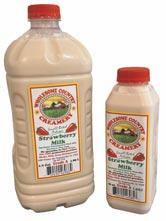






Often, I receive many more photos than there is space for, so I have begun to add some of these photos to our website. You might even find a video now and then, or some extended content if space does not allow for printing it.
yadkinvalleymagazine.com

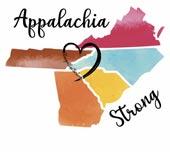
Trying out a YVM recipe? Be sure to tag us on social media if you post a picture!


Spring has defintitely sprung! On a recent windy day, the pink blossoms from my cherry tree looked like pink snow blowing around, and those sweet little chicks from a month ago have really grown. Hopefully this pollen will clear soon so we can all enjoy this spectacular weather before the heat of summer arrives.
I know we don’t usually think of this time of year as a holiday season, but three pretty important ones are coming up. Celebrate your mom and dad, or maybe someone who was like a mom or dad to you. Maybe you only get to celebrate their memory, and hopefully that brings you joy, too. Memorial Day may be the unofficial start of summer, but let it be much more than that.
This issue is packed! We have squeezed in as many great recipes, articles and ads as we possibly can, and hope that you find something that interests you.
In the Yadkin River series, read about the efforts in Wilkes County to protect this resource. Read about some interesting people who call the Yadkin Valley home. Check out some local events. Be sure to try out a recipe or two. There is plenty of variety in this issue for sure!
I hope you were able to attend an event or two during the Writers Road Show Authors Tour. If you missed it, there are some highlights on page 52. More author events are planned at Books & Brew in East Bend and Pages in Mount Airy, so be sure to check those out. Your favorite advertisers make Yadkin Valley Magazine possible, so be sure to support them as often as you can!
Months after Hurricane Helene, the needs of our neighbors in western North Carolina continue to be overwhelming. Please read pages 50-51, “People Helping People”, for an overview of one local organization’s continued efforts to provide relief. Please donate if you are able, either to them or to another reputable organization.
Our telephone number is 336-961-2620 web address: yadkinvalleymagazine.com
Please email the following: Advertising Inquiries Weekends/Events Calendar Submissions
BEST Yadkin Valley COOKS recipes Pet Photos to: yadkinvalleymagazine@gmail.com



Yadkin Valley Magazine assumes no responsibility for unsolicited materials. Entire contents copyright 2024 All rights reserved. Reproduction of our created advertising materials and design work are strictly prohibited. Yadkin Valley Living, Yadkin Valley Magazine, Yadkin Valley Weekends, Best Yadkin Valley Cooks, 52 Pounds and then some!, are trademarks of Crossroads Publishing LLC, PO Box 2077, Yadkinville, NC 27055.
Proudly printed in the USA. Every effort has been made to ensure the accuracy of the information contained in the magazine. We assume no responsibility for changes in schedules, prices, hours or information.
Before travelling long distances, it is always wise to use the contact numbers included in the magazine to confirm that the events you wish to enjoy are still on schedule.
The contents of advertising and articles do not necessarily represent the views of the publisher. The publishers assume no responsibility for errors or omissions of any advertisement beyond the actual cost of the advertisement.
In no event shall the publishers be liable for any consequenstial damage or any damages in excess of the cost of the advertisement.
We offer solutions for: tough industrial applications commercial painting water fountains • concrete steps decks • car wash walls office buildings • homes concrete swimming pools garage floors painted AND sealed to withstand heat and water
Got a painting project— we can do it!
Before you replace the wood on your deck, talk to us about…DECK RESTORE™ or DECK REVIVE products. Both products revive and protect wood surfaces such as wood and composite decking, stairs, docks and more. They install at a fraction of the cost of total surface replacement while adding years of life to older wood decks!



Our Design Specialist can offer creative ideas on any painting project. Whether you’re just needing a little guidance… or the whole idea.
Want to see more before & after samples of our work? Call me today and I’ll be glad to bring photos by for you to see. Discover how our superior protective coatings stand up to the toughest elements Mother Nature can throw at it.
How much will it cost?
My consultation visit and estimate are FREE. —Mark Diachenko Mark@PaintandCoatingsLTD.com


I recently taught art to twelve middle school students. This opportunity was made possible through a partnership between John C. Campbell Folk School and the North Carolina Museum of Art (NCMA) to participate in the Artist Innovation Mentorship (AIM) program. https://ncartmuseum.org/statewide-outreach ncma-aim/
We met for twelve, ninety-minute sessions after school over a six-week period. This was a stretch for me because I hadn’t taught 6th and 7th graders before. When I sought out local middle school teachers for advice their response was, Oh, I hope they behave, which did nothing to bolster my confidence.
I wondered how much art experience they already had? I didn’t want to plan activities they’d already done. I googled middle school art projects. I listened to middle school teacher podcasts. I studied metaphors in art, neurographic art, zentangle, watercolor weaving and Burtonesque portraiture, drawing a Tim Burton style portrait. All projects I thought would appeal and be a fun challenge.
That first session I didn’t know what to expect. Oh, I hope they behave, having been replaying in my mind, causing me to feel braced for anything. But that was before I knew I had Wendy in my corner. Wendy, one of the school’s educators, present at every session with her generous heart and iron fist. The students love Wendy. I do too.
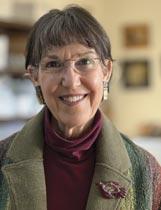
We all learned as we went along. Not everyone was able to attend every session and often some needed to leave early. I realized early on, sessions needed to be singular; comprised
of seventy percent fun and thirty percent challenge for highest engagement.
A turning point for me was when I introduced watercolor supplies. They gathered around me wide-eyed as I explained regulating water pigment ratio and color mixing. I’d observed adult students’ hesitation and uncertainty when first trying watercolor, barely touching brush to pigment and onto paper and was expecting something similar.
Each student received a twelve-pan set of watercolors, ten brushes and watercolor paper. They raced back to their tables, filled their water buckets, and the room erupted into a joyous blur of laughter, color and fun. Had they listened to anything I’d said?
I turned to Wendy, “I guess I should just let them go.” She laughed. “I would.”
Adult beginning watercolor students have to be coaxed to dip their toes into the water, middle school students splash in like cannon balls. Their unabashed zeal was refreshing and inspiring. Maybe not behaving sometimes is a good thing. I returned to my own studio with an energized boldness.
In a later session, I explained how to write an artist’s statement. Again, they moved me. Their vulnerable unpretentious authentic self-expression is fuel for powerful art making. Below are some excerpts.
I love art because I like putting my focus on something to escape life.
I love art because it has no mistakes. It is very calming. I love to make art because it lets me express my emotions without making me tell people. I don’t care what others think, just as long as I like it.
I love art because I often feel disconnected from myself, but when I’m making art I feel like I’m really there.
Let’s learn from them. We need art.
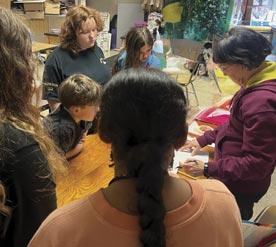
Pulsed Electromagnetic Field Therapy
This therapy works deep in your body’s cells to promote healing of muscles, tissue and bone, alleviating pain from inflammation and arthritis, sports injuries at any age, sore muscles or even old injuries. Improve overall wellness, treat anxiety, or increase your energy with PEMF treatment!
Whether you’ve had a whiplash injury, took a fall, or just overdid it at the gym, let us help you heal naturally! These types of injuries involve your soft tissue, which consists of nerves, muscles, tendons, ligaments and cartilage. Unlike broken bones, soft tissue injuries can take years to heal.
If your spine is out of alignment, it can cause tissue tears, irritation, inflammation and scar tissue. When ignored,this can lead to altered biomechanics, spinal degeneration and disabling osteoarthritis.
Chiropractic care can improve your joint range of mo- tion and break up scar tissue, increase your circulation and reduce inflammation for a faster more complete healing. A Chiropractic adjustment is a controlled motion that can restore the alignment and function of your spine. The Open Rehabilitation Journal states controlled motion “can stimulate the repair and restoration of function.”
Everyday is More Fun When You Feel Fantastic!.
We see patients every day that come in struggling to walk, lift or turn their heads. Yet, after completing their program of Chiropractic care they have returned to their normal activities.
Don’t suffer needlessly from misaligned, injured and inflexible spinal joints. Spinal adjustments effectively reduce pain and enhance health... without drugs or surgery!
Let us help you and the people you care about live healthier and more active lives. CALL NOW!

204 North State Street, Yadkinville (across from Yadkinville Elementary School)

Call: (336) 679-8500 for an appointment www.yadkinvillechiro.com.
We Appreciate Your Referrals!

Every year on the third Sunday in May, the descendants of L. L. and Martha Ellen (Crater) Trivette gather for a family reunion. The tradition started when Grandmother Trivette shared that she did not care whether her children were all home for Mother’s Day, but she wanted them all home to celebrate her birthday which was May 21, 1873. After our Grandmother died in 1951, the children, Lee, Cleo, Paul, Charlie, Bruce, Effie, Hubert, and Grace, took turns hosting the reunion. Uncle Hubert and Aunt Daisy lived in Maryland, and we didn’t go there. As a kid I couldn’t understand why. I do now.
The country relatives, held the reunion in their backyard. In the early years, we just pulled up a trailer that was used for everything, put a tablecloth on it, and you had a serving table. We looked forward to going to Uncle Paul’s and Etta’s home in Forsyth County. They had a pond in which we could fish or just run around throwing rocks into the water. The city relatives would host the reunion at their home or a public park in Winston-Salem. Driving to Winston-Salem for anything was a big deal back then. When the first cousins were young, we looked forward to our reunion the way we looked forward to Christmas. It was always such a fun time. All of the cousins were together to play and eat all the good food our aunts cooked. There was Aunt Minnie’s butterscotch pies, Aunt Effie’s strawberry short cake, Aunt Cleo’s egg pies, and Aunt Grace’s German Chocolate cake. We did have something other than desserts. We all remember Aunt Geneva’s deep-fried chicken. Each aunt had her own special meal that she prepared. Although I cannot remember what all of them were now, it was all good. There was ham, pork roast, chicken pie, green beans, corn, congealed salads, greens, deviled eggs, potato salad, and the list goes on.
Our cousin, Madeline, always brought Krispy Kreme donuts. This was a real treat. And who can forget the cooler full of little bottled Cokes that Uncle Bruce brought. You got a whole Coke that you did not have to share with a brother or sister!
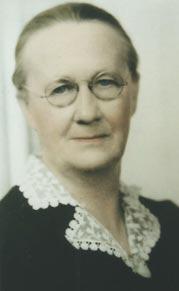
Martha Ellen Crater Trivette
At supper time, our aunts would bring out loaves of bread and tomatoes for tomato sandwiches. There were so many of us, that we pretty well wiped out everything else at dinner time. (We did not have lunch and dinner. We had dinner and supper.)
We look forward to some of the same menu items that our aunts fixed, and we have some new ones. Ramona’s chicken and dumplings, Sylvia Crater’s pound cakes (We never know if it will be chocolate with white frosting or vanilla with chocolate frosting.), Sylvia Campbell’s chocolate pies… and of course, a favorite – Kentucky Fried chicken. Unfortunately, some of our favorite food recipes have been lost over time.
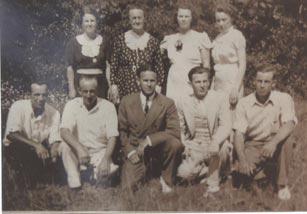
Our family has always been close – especially the first cousins. Many of us went to church together at Shiloh Baptist Church, went to West Yadkin School together, and worked in tobacco together. We are closer than many siblings are. We share one another’s sorrows and celebrate all the joys.
In an effort to keep in touch, we meet on the last Friday in the month at 11:30 am at Clemmons Kitchen for a meal. Some of the Winston-Salem cousins meet weekly to play cards. We have started having a game day. We have a sandwich and play a variety of games – Rook is very poplar. We talk and laugh and just enjoy one another.
In recent years, it is bittersweet when we gather for the reunion. We welcome and celebrate our new births, but we miss all of our loved ones who are no longer with us. God has blessed our family beyond measure. We are so grateful for each other and the love we have for one another.
Nell Henderson 1994
Modified over time by Ramona H. Trivette Serves 10-15
Chicken
3 large split chicken breasts with the rib (something with the bone)
2 Chicken Bouillon cubes
3 ½ Quarts Water
Do not add salt
Wash chicken thoroughly. Remove the skin and fat. Soak in cold salt water overnight or for several hours. Rinse well. Stew the chicken. Debone the chicken and tear in small pieces. Strain broth. Do not add cooked chicken to broth. Set the chicken aside for later use. Cook in a tall stock pot.
The above can be done before you actually make the chicken and dumplings.
Broth from cooked chicken (reserve 1 cup for thickening)
1 can Cream of Chicken soup
1 can Cream of Celery soup
1 1/2 stick of butter
Do not add salt
Take the strained broth from the chicken and heat until it is hot. Add the Cream of Chicken and Cream of Celery soup to the chicken broth. *Bring the broth mixture to a boil. Strain the mixture to remove the bits of celery and chicken.
Take about one cup of the broth before it is boiled and add to ½ cup sifted self-rising flour. Mix well and strain any lumps out before adding to broth so there won’t be lumps. Cook until desired thickness.
Sylvia Trivette Campbell
2 cups of milk
1 cup of sugar
2 tablespoons of cocoa
5 tablespoons of self-rising flour
2 egg yolks – slightly beaten
1 teaspoon of vanilla
1 cup of self-rising White Lily flour
1 cup plain White Lily flour
2 scant tablespoons of Crisco ½ to ¾ cup milk.
You want a fairly stiff dough. Sift flour together and cut Crisco into flour with a pastry cutter. Add milk a little at a time and mix. Then knead dough. Divide dough into 3 long rolls. Wrap in wax paper and put in a plastic bag. Chill a few hours or overnight. The dumplings should be prepared at least 1 day before you actually make the chicken and dumplings.
When you are ready to cook the dumplings, put the broth mixture on the stove and began heating it. Roll the dough fairly thin on a floured board or wax paper. Cut into long strips. Pull apart with your hand or cut and drop the dough strips one at a time into the boiling broth. DO NOT STIR the mixture once the dough is added to the broth or it will become mushy. Once the entire mixture has started to cook, stir gently from the bottom of the pot with a wooden spoon. Turn heat to low. Cook uncovered until done – approximately 10 to 15 mins.
Serve in a crockpot. Put some of the broth mixture into the crockpot first. Layer with alternating layers of chicken and dumplings, adding broth as needed. Add black pepper to taste. Taste and add salt if desired.
Geraldine and her daughter Laura went to a chicken and dumpling demonstration at Ramona’s house on August 4, 2015.
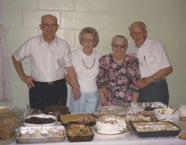
Mix dry ingredients together. Stir in milk. While whisking, cook until it begins to thicken. Blend a little of the hot mixture into egg yolks. (Have the egg yolks in a separate container and add the hot mixture. Then pour the egg yolk and hot mixture back into the larger pan.) Combine all and cook until it thickens. Pour into a pie shell which has been baked.
Makes one pie.
Meringue: Use two egg whites. Beat until fluffy and add a tablespoon of sugar. If they beat well, good. If not, throw away and use Cool Whip.
½ lb. margarine (butter) 2 sticks
½ cup Crisco
3 cups sugar
5 eggs
3 cups plain flour or Swans Down Cake flour
½ tsp baking powder
1 cup milk
1 lb. Hershey’s Chocolate syrup
1 tsp vanilla
“Start in cold oven”
Do not open oven door for 1 hour. Cook 325 degrees for 1 hr. 15 mins. or until toothpick inserted in cake comes out clean.
Thank you to Geraldine Henderson Brannon for sharing the story of her family’s reunions, and the recipes on pages 25-26. She is the grandaughter of Martha Trivette and the daughter of Effie Trivette Henderson.
1 cup Crisco
¼ cup margarine (4 tablespoons)
1 lb. confectioner’s sugar
¼ tsp. vanilla
½ small can evaporated milk
Blend shortening, margarine, confectioner’s sugar and vanilla thoroughly. Add milk to mixture until ease of spreading consistency. May be stored in refrigerator for about a week.
Before you begin, assemble all ingredients. Bake and cool pie crusts – homemade or Pillsbury
This recipe yields one of the following quantities:
Two thin pies or One medium and one small pie or One thick pie
1 lb. box light Dixie Crystal brown sugar
1 stick margarine (butter is too rich)
½ cup milk
4 egg yolks (save the whites)
2 cups milk (2% or whole)
¾ cup self-rising flour (sift twice)
Combine the first three ingredients in a stainless steel or iron skillet on medium heat and bring the mixture to a boil until thick and bubbly – approximately 5 minutes. You must stir it constantly or it will stick and burn.
Sift flour twice. Add a small amount of milk from the two cups. Beat with a whisk so there are no lumps. (Use blender. Strain the mixture so there are no lumps.) Beat egg yolks with the remainder of the two cups of milk and gradually add to the brown sugar mixture. Mix well.
Cook until thick – stirring constancy – approximately 12 minutes. (I use my hand mixer to mix well.) Pour into baked pie shell.
Meringue
1 tablespoon cornstarch
2 tablespoons cold water
½ cup boiling water
4 egg whites
6 tablespoons white sugar
1 teaspoon vanilla flavoring (either dark or white)
Pinch of salt
Blend cornstarch and cold water in a saucepan. Add boiling water and cook - stirring until clear and thickened. Let stand until completely cold. With electric beater at high speed, beat egg whites until foamy. Gradually add sugar and beat until stiff but not dry. Turn mixer to low speed; add salt and vanilla. Gradually beat in cold cornstarch mixture. Turn mixer again to high and beat well. Spread meringue over cooled pie filling. Bake at 350 degs. for 10 minutes or until top is lightly browned.
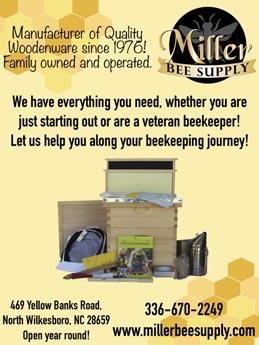
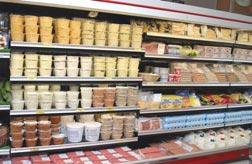
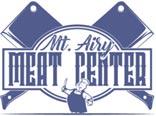





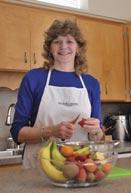

Carmen Long
Family and Consumer Agent
N.C. Cooperative Extension Surry & Alleghany county centers.
Wouldn’t it be wonderful to be able to pull a complete meal out of the refrigerator? With a little planning, this dream can become a reality. Try a salad meal. Anyone who believes salads are only made with iceberg lettuce just does not know what they are missing. Salad possibilities are endless. Salads can be the main dish, side dishes and desserts. Use the MyPlate guidelines to ensure you have enough variety to cover all of the food groups. Think about preparing some salads utilizing vegetables and fruits. These should cover about one half of the plate. One fourth of the plate needs protein. This could include lean meats and poultry or dried beans. Try a hot chicken salad or a bean salad. The other fourth will be filled with a grain salad. Options may
Tuna, White Bean and Dill Salad
Serves 4
Serving Size: 2 cups
Prep Time: 20 minutes
Ingredients:
include a pasta salad, or a salad with quinoa, brown rice, or barley.
Some salads, like Tuna, White Bean and Dill Salad incorporate multiple food groups. Often tuna is eaten with just a lot of mayonnaise. This recipe incorporates so much more and is as satisfying and delicious as it is good for you.
Tuna, White Bean and Dill Salad makes 4 servings and is a great recipe to meal prep so your lunch will be ready to grab out of the refrigerator several days a week. If you decide to do meal prep, wait and toss the spin-
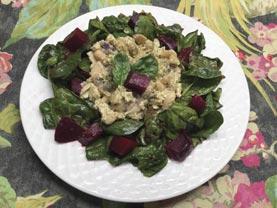
1 (15 oz) can no salt added cannellini beans (white kidney beans), rinsed and drained
2 (5 oz) cans solid white tuna (water packed) drained and broken into chunks
1/3 to ½ cup chopped red onion (1 small)
3 tablespoons + 1 teaspoon, honey Dijon-style mustard, divided
2 tablespoons light mayonnaise
2 tablespoons cider vinegar, divided
1 ½ teaspoons dried dill, divided
2 tablespoons olive oil
¼ teaspoons kosher salt
6 cups fresh baby spinach
1 (15 oz) can sliced beets
Optional: a sprig of chopped fresh dill, lemon pepper and/ or ground pepper
Directions:
Combine beans, tuna and onion (can cook onion for a few minutes if you like). For dressing, whisk together 3 tablespoons of the mustard, the mayonnaise, 1 tablespoon of the vinegar, 1 teaspoon of the dried dill and lemon pepper seasoning to taste in a small bowl. Add dressing to the tuna mixture; toss gently to coat. Cover and chill for 2 to 4 hours.
Prepare vinaigrette: Combine oil, remaining 1 tablespoon vinegar, remaining 1 teaspoon mustard, salt, and the remaining 1/8 teaspoon dried dill in a small screw-top jar. Cover and shake well. Combine spinach and beets in a large bowl. Before serving, pour vinaigrette over spinach mixture, toss gently to coat.
To serve, place the spinach/beet mixture on 4 plates or if meal prepping you can use refrigerator containers. Top with the tuna/bean mixture. If desired, sprinkle with fresh dill and/or pepper.
ach with the dressing when you are ready to eat the salad. Even if you decide to not make a complete meal of salads, use a couple of salads as sides to compliment a simple sandwich or piece of grilled chicken. Remember recipes are just guides. Salads are flexible enough for you to add or subtract ingredients to suit your family’s taste preferences and to use ingredients you have available. Be creative and utilize salads to make your life more convenient. Having the majority of the clean-up already completed before the meal begins is another plus. The concept works well when having company or if you need to make food ahead so it will be ready to eat when you are. For a fun group event, have everyone bring their favorite salad to a covered dish salad meal. Celebrate Salad Month this May and enjoy some delicious, nutritious flavors and quick and easy meals.
Source: EatingWell
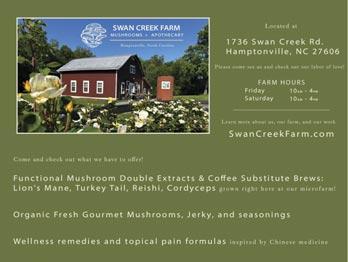
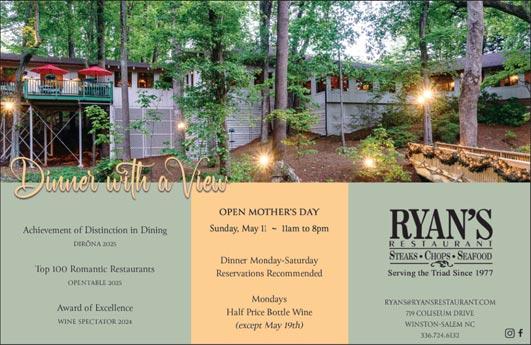
Elisa Phillips
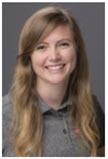
WRITER & PHOTOS
Elisa Phillips
Family and Consumer Sciences Agent
NC Cooperative Extension Wilkes County
Looking for a simple, protein-packed recipe that’s perfect for meal prep? These Jalapeño Cheddar Protein Biscuits are easy to make, freezer-friendly, and incredibly satisfying. Made with Greek yogurt, eggs, and reduced-fat cheddar, they’re protein-packed to keep you full and energized. The addition of ground flaxseed provides heart-healthy omega-3s and fiber for extra nutrition, while the diced jalapeños add a delicious kick. Bake a batch in advance, freeze for later, and enjoy a quick, wholesome breakfast or snack anytime!
Recipe courtesy of Catherine Hill, Registered Dietician & Nutrition Programs Manager at NC State University
Serves: 12. Serving size: 1 protein biscuit

Prep time: 5 minutes Cook time: 25 minutes Total time: 30 minutes
Ingredients
2 cups plain nonfat Greek yogurt
2 eggs
1-2 jalapenos, diced
1 ½ cups reduced-fat cheddar cheese, shredded
1 teaspoon garlic powder
2 Tablespoons baking powder
1 teaspoon kosher salt
2 cups all-purpose flour
¼ cup ground flaxseed
Cooking spray
Directions
Preheat the oven 400°F and line two baking trays with parchment paper or use cooking spray. In a medium mixing bowl, add yogurt, eggs, jalapenos, cheese, garlic powder, baking powder, and kosher salt. Stir to combine.
Fold in flour and ground flaxseeds. With a large spoon or flat spatula, start at the bottom of the bowl, scoop upward, and fold it over the top in a slow, sweeping motion. Rotate the bowl slightly with each fold to ensure even mixing. Continue until just combined. Do not overmix. Dough should be thick and sticky. If too wet, add more flour starting with ⅛ cup at a time. Spray a ⅓ measuring cup with cooking spray to help dough release while scooping. Scoop ⅓ cup of the batter onto the baking tray. The dough should yield about 12 biscuits - 6 biscuits per tray. Leave space around each biscuit to account for rising while cooking.
Optional: top each biscuit with a sprinkle of cheddar cheese and sliced jalapenos. Bake at 400°F for 5 minutes, then decrease the temperature to 350°F and bake for an additional 20 minutes (do not open the oven in between). Biscuits should be golden brown on the bottom once done. Cool for 5 minutes on the baking trays and then remove to a wire rack until completely cooled.

Our Popular Reuben SandwichThe Dellinger Mill!
Plenty of Delicious Corned Beef and Fresh Sauerkraut with Swiss Cheese and Thousand Isle Dressing Grilled to Perfection on Marble Rye Bread
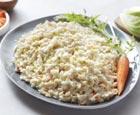
Some of Our Many Popular Sandwiches, Wraps & Salads... AMISH COLESLAW
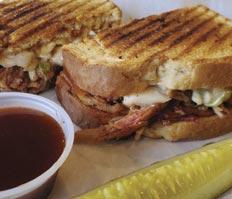
Our Delicious Hickory Smoked Pulled Pork BBQ SandwichNamed for the Dobbins Mill. Pulled Pork BBQ with Apple Butter BBQ Sauce & Coleslaw on Toasted Sourdough Bread,
Fresh Cabbage Mixed with Shredded Carrots and Celery Seed in a Special Slaw Dressing AMISH POTATO SALAD
Fresh Cooked Potatoes, Diced Eggs, Onions and Shredded Carrots in a Sweet Celery Seed Dressing





ShaRee H. Parker


ShaRee H. Parker
ShaRee H. Parker
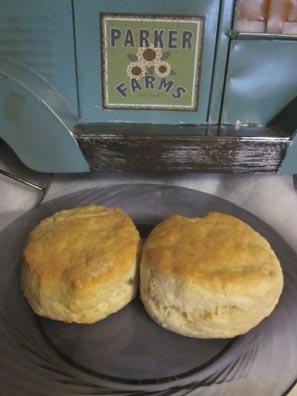
2 cups self-rising flour, sifted 1 cup heavy whipping cream
Preheat the oven to 450 degrees. Place sifted self-rising flour into a large mixing bowl. Gradually add heavy whipping cream and stir until combined, adding a small amount of additional heavy whipping cream, if necessary for the dough to hold together. Place dough onto a floured surface and knead until smooth. Using a rolling pin, roll dough until approximately 1-inch thick. Cut dough with a biscuit cutter dipped in flour. Place biscuits onto an ungreased baking sheet about 2-inches apart. Bake in a preheated oven for approximately 10-12 minutes or until golden brown. Brush with melted butter, if desired.
I don’t know where this recipe for 2-Ingredients
Biscuits originated, but it is a genius and simple recipe. I’ve shared this recipe many times and everyone has been very impressed with these biscuits. I’ve even shown my husband, Terry, how to make them! Enjoy!










Lisa Prince
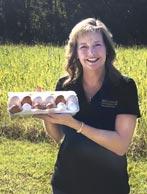
Lisa Prince, Director, NC Egg Association
Find a recipe for Air Fryer Egg Bites at yadkinvalleymagazine.com
Don’t throw away those eggshells! They are incredibly versatile and can be used in a variety of ways.
Garden Fertilizer
Crushed eggshells are a great source of calcium. This helps to fertilize the soil and calcium is essential for plant growth. Crush up the shells and sprinkle them around your plants. Starting a new bed, work them into the soil.
Household Cleaner
Eggshells can be used to help clean your pots and pans and aren’t abrasive like some cleansers. Use crushed eggshells with soapy water.
Seed Starter
Use eggshells as small pots for starting seeds. They can be planted directly into the soil because they are biodegradable.
Need to deter garden pests like slugs and snails? Scatter crushed eggshells around your garden to create a barrier that these pests won’t cross.
Add eggshells to your compost pile. They break down and help balance the pH of the compost, enriching it with valuable nutrients.
https://ncegg.org/recipes/mediterranean-chopped-salad
Prep Time: 20 minutes. Servings: 4
4 hard-boiled large eggs, cooled to room temperature, peeled and quartered
6 cups packed chopped romaine lettuce hearts
1 cup halved cherry tomatoes
1 cup chopped cucumber
1 cup canned chickpeas, rinsed and drained
1/4 cup pitted quartered Kalamata olives
1/4 cup crumbled feta cheese
2 tablespoons red wine vinegar
1 tablespoon each finely chopped fresh parsley and chives
1 teaspoon Dijon mustard
1/4 cup extra-virgin olive oil
Combine lettuce, tomatoes, cucumber, chickpeas and olives in a large bowl. Top with feta cheese. Whisk together vinegar, parsley, chives and mustard in a small bowl. Add olive oil slowly, whisking until combined. Toss salad lightly with dressing and divide evenly among 4 dinner plates. Top with eggs.
Pro Tip: Try packing this salad in a Mason jar and take your salad to go. Add dressing immediately before eating.
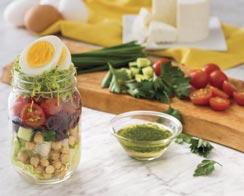


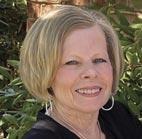
The end of spring and beginning of summer arrive in May and June. May is a month of warmer weather with blooming plants really beginning to catch our eyes. As a teacher we started out May thinking about our mothers and how special they were. We made small gifts and colorful cards to show them our love. Memorial Day comes at the end of May, so our thoughts turn to outside activities. We are so thankful for the men and women that sacrificed their lives to give us the freedoms we enjoy today. We must never forget that our freedoms came at a high price for many Americans. Fly your flags proudly. Baseball and cookouts are always at the top of the list for Memorial Day weekend. As we began to think about the end of school in June, we can’t forget about our dads. We made them unique cards in the shape of a necktie and decorated them for Father’s Day.
As we celebrate Mothers and Fathers this month, making them something from the kitchen always touches their hearts. This month’s recipes are Chicken Stir Fry and Lemon Lime White Chocolate Chip cookies. The chicken recipe is one of my husband’s favorite meals. Since most Chinese restaurants are not gluten free, we have to rely on Chinese food made at home. This meal is so easy and yet so tasty. I personally love the Lemon Lime White Chocolate Chip cookies because I love anything that has lemon or lime in it. I get many compliments each time I make these for friends. Both recipes have a few substitutions if you are cooking gluten free. I have listed in parentheses the gluten free brands I use and recommend. Please remember all gluten free flours are not the same, so if you use a different flour, I am not sure the results will be the same.
Happy Mother’s Day! Happy Father’s Day! God Bless the USA!
Blessings
2 cups cooked shredded chicken (or raw shrimp)
1 bag deluxe stir fry vegetables
Stir Fry Sauce
½ cup honey
6 tablespoons soy sauce (Kikkoman gluten free)
1/3 cup chicken broth (Swanson is gluten free)
1 ½ teaspoons sesame oil
1 ½ tablespoons cornstarch (Argo is gluten free)
1 ½ teaspoons ginger
1 tablespoon minced garlic
Cashews for topping
Combine all ingredients for sauce in a small bowl. Set aside. Cook vegetables according to package directions in a large skillet until almost done. Add the chicken (or raw deveined, tail off shrimp). Cook another 5 minutes on medium heat. Pour sauce over meat and vegetables and cook another minute until sauce thickens. Serve over rice and top with roasted cashews.

2 ¼ cups all purpose flour (King Arthur Measure for Measure gluten free flour is what I use)
1 teaspoon baking soda
¼ teaspoon kosher salt
2 sticks (1 cup) unsalted butter, at room temperature
¾ cup light brown sugar
¾ cup granulated sugar
1 large egg, at room temperature
2 tablespoons lemon zest
2 tablespoons lime zest
1 tablespoon vanilla extract
2 cups white chocolate chips (Nestle or Ghirardelli are gluten free)
Preheat oven to 375 °. Line two baking sheets with parchment paper. Add the flour, baking soda and salt to a medium bowl and whisk to combine. Set aside. Add the butter and sugars to the bowl of a stand mixer fitted with the paddle attachment. Cream the butter and sugar together until lighter in color and fluffy, 1-2 minutes, scraping bowl as needed. Add the egg and beat until combined. Add the lemon zest, lime zest and vanilla extract. Beat until combined. Add the dry ingredients to the butter/sugar mixture and mix just until combined. Do not over mix. Fold in the chocolate chips. If making cookies gluten free, let the dough rest for 20 minutes. Use a 1 tablespoon cookie scoop to put cookies 2“ apart on baking sheet . Bake until the edges are brown and centers are soft, about 8-10 minutes. Cool the cookies on the baking sheets for 5 minutes and then transfer to a wire rack to cool completely.



The Sweet Shack Bakery
111 West Main Street
Boonville, NC
336-467-0963
Find a recipe for Pansy Topped Shortbread Cookies at yadkinvalleymagazine.com
Try these Viola Tea Sandwiches for something savory.
Ingredients
4 oz. cream cheese, softened
1 teaspoon snipped fresh lemon thyme/chives
¼ teaspoon cracked black pepper
¼ cup violas, chopped
4 slices brioche or challah bread, crusts trimmed, if desired, and cut into quarters
Toppers: thin radish slices, thin cucumber slices, microgreens, and whole viola flowers
Flaked sea salt (optional)
Directions
Make the Spread
In a small bowl stir together the cream cheese, lemon thyme, and black pepper until smooth.
Stir in chopped violas.
Assemble Viola Tea Sandwiches
Spread cheese mixture over brioche slices. Add toppers. Sprinkle with flaked sea salt, if desired.
Spring is peak edible flower season, so even if you wouldn’t pop a pansy in your mouth on a bet, I’ve got a few edible flower recipes that will inspire you to freshen up your tired meal plans, guaranteed!
It’s not all about wedding showers and tea parties ~ there are lots of ways to include edible blossoms in your everyday meals. I love the idea of snipping a few flowers from the garden to turn a plain salad into a celebration of spring, but you can buy containers of edible flowers in the produce section of lots of markets now, too, so nothing should stop you from getting in on this fun trend.
Calendula petals can be a bit spicy and are often referred to as the poor man’s saffron because of the color they lend to dishes. Sprinkle on chilled salads, roasted/grilled vegetables, use to color rice, or add to a savory butter recipe.
Borage flowers are a brilliant blue. Tender, young leaves and flowers have a cucumber-like flavor.
Dandelion blooms are best when young and tender. Most often you’ll hear about the use of leaves in salads, but petals of the dense heads can be used in baking or savory dishes and as a garnish.
Elderflowers are commonly used in preparing simple syrups.
Gladiola are lovely when stuffed with a light filling. The petals can also be added to salads.
Scented geranium is my garden favorite! The tiny flowers are edible but the oil in the leaves yields a fabulous flavor and scent. Use for baking, jelly, sugar, or
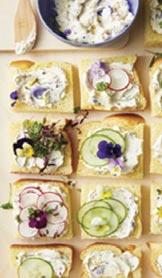
tea. There are many scented varieties. Have fun with this!
Lilac flowers can be used in salads, jelly, baked goods, butter, infused alcohol, or simple syrups.
Nasturtium leaves and flowers are edible with a spicy, peppery flavor. Use in salads and garnish. Add petals to tea sandwiches or coleslaw recipes.
Orchids (Vanilla, Dendrobium, and Cymbidium are the edible varieties.) The petals are edible and have a cucumber-like flavor. Ideal savory and dessert garnish.
Roses are dreamy in beverages, salads, baking mixes, and garnishes. Gently remove the petals as you wash the flower and look for insects. Often the white base can be bitter; remove if necessary.
Squash Blossoms make the perfect wrap for fillings. Be sure to clean and remove the pistil.
Tulip petals make a perfect vessel for dip, salads, ice cream, mouse, or sorbet. Pistils and stamens need to be removed before eating. Young and tender petals are best. Like daylilies, tulips may cause stomach upset.
Violets are a cook's dream flower, with all the colors of the rainbow. Add to a fresh greens salad, use in cake or muffin batter, or sugar coat for decoration.
Herb Flowers. Garnish and season a dish with these buds: Chives, basil, lavender, thyme, dill, fennel, or arugula.
Pansies are one of the prettiest and most widely available edible flowers. Pansies start to bloom in early spring and continue right through the summer. They have a mild, slightly sweet and grassy flavor. These stunning (and easy!) pansy topped cookies are one of my favorite edible flower recipes.



►Only share your Medicare or Social Security number with those you trust.
►Only carry your Medicare card when you need it.
►Keep a record of all your medical visits and procedures.
►Review your Medicare statements for mistakes like charges you don’t recognize or duplicate billing.
►Call your health care provider, Medicare, or your local SMP if you see something suspicious.


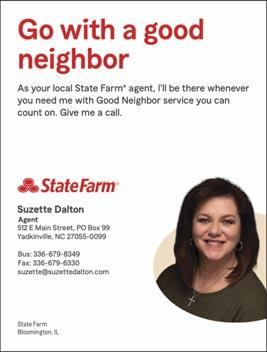
Chelsea Johnson

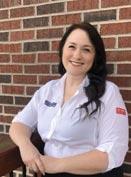
WRITER & PHOTOS
Chelsea Johnson
Family and Consumer Agent
N.C. Cooperative Extension Yadkin County Cooperative Extension
Written by: More In My Basket-Adapted by Chelsea Johnson, FCS
Though it may be common knowledge that healthy eating should be a part of your meal planning, it can be difficult to find the right information to follow. This is why we have compiled the following list of tips on how to eat healthier, according to the Centers for Disease Control and Prevention (CDC). Each of the healthy swaps listed can be done with SNAP benefits.
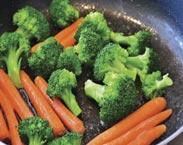
If you already include fruits in your diet, but do not know how else to branch out beyond bananas and apples, try mangos, pineapples and kiwis or other fruit you don’t normally add to your diet. You can do so by adding these items to your cereal or fruit salad. Frozen, fresh, and canned fruits are all options, but choose canned varieties without added sugars or syrups.
Add a variety of vegetables to your salads or side dishes. If you choose to grill or steam them, add herbs and spices to give the vegetables flavor. You can also pan-fry your vegetables using a small amount of cooking spray. Frozen and canned vegetables are nutritious alternatives that often save money, but opt for those without added salt or sauces.
If you enjoy adding meats to your diet, choose leaner cuts such as chicken breast or white-fleshed fish. Remove any visible fat from the meat before cooking it and avoid frying it. Baking or grilling your meat will be healthier options. Cooking with unsaturated oils (olive, sunflower and rapeseed) is also a plus.
Avoid processed meats as much as possible, such as salami, sausages and bacon. Swapping red meats for fish, chicken and turkey is also a great idea. If you need another protein replacement, consider purchasing chickpeas, beans or lentils.
Consuming too much sodium can lead to an increase in your blood pressure and add more risk for heart disease and stroke. One way to avoid buying too many food items with a high sodium intake is looking for packaged foods that are labeled with “low sodium,” “reduced sodium” or “no salt added.”
The Nutrition Facts label on the back of different products should also give you all the information you need about sodium levels. Check the amount of sodium per serving (as well as the number of servings per container) then choose the option with the lowest amount of sodium. When it comes to fresh items, check if saline or salt solutions have been added to the product. If so, find another brand without these. You can also ask your grocer if they have a low sodium shopping list available. When cooking at home, reduce the amount of salt used in your meals. Some alternatives to adding salt to recipes are using garlic, citrus juice, salt-free seasonings and spices. Avoid sauces, mixes and instant products that are flavored with salt.
Eating healthier does not have to mean eating things you don’t like. You can still enjoy comfort foods if they are high in calories, fat or sugars, as long as you do so occasionally and not every day.
Besides eating them less often, you should also eat smaller amounts of these types of food or look for
continued next page
by Emerie Mullis-Junior 4-H
Ingredients
1 dozen eggs
1/2 pound ham, cut or shredded
5 slices of American cheese, cut into smaller pieces 1/2 stick butter
Salt and Pepper to taste
Directions:
Place reusable cupcake holders on an oven safe pan. Put 1/4 pat of butter in each one. Preheat the oven to 350 degrees. Crack open eggs into a large mixing bowl. Add salt and pepper to taste. Beat well. Add ham and cheese and mix well. Place cupcake cups with butter in the oven for about 2 minutes (until butter is melted).
Remove from the oven and pour in egg mixture. Place back in the oven for 25 to 30 minutes. Remove and enjoy. Can store in an airtight container in the fridge for quick weekday breakfast.
Healthier Choices, continued
lower-calorie versions of that product. For example, in a macaroni and cheese recipe that usually requires you to add whole milk, butter and full-fat cheese, you can remake it by using non-fat milk, less butter and low-fat cheese. Adding spinach, tomatoes or any of your other vegetables will also help balance the meal.
By taking these easy steps, you can make a world of difference in the foods you are consuming every week. Combine that with some exercising and you will be working toward a healthier lifestyle for yourself as well as your family. LOCAL
2909 Nebo Road, East Bend, NC
Saturday, June 14th,10 AM - 1 PM

Watch for our postings on FACEBOOK for summer activities for the kids!
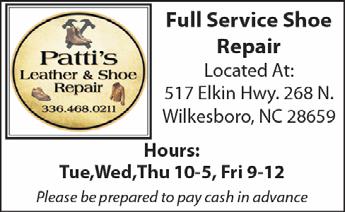


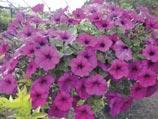




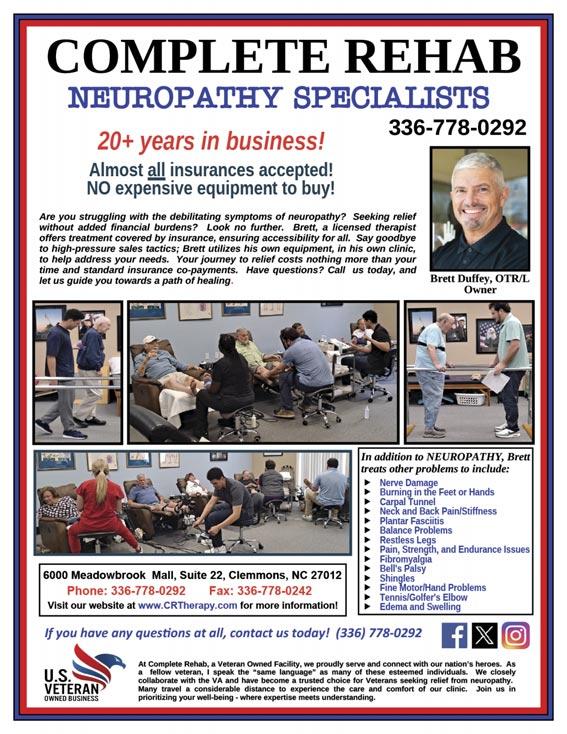



Madaline Jones
Madaline Jones
4-H Agent
Yadkin County madaline_jones@ncsu.edu
In the summer, many parents consider sending their children on a camp experience, but did you know that North Carolina 4-H offers their own camps? Yes, that’s right! According to the North Carolina 4-H Page, “For more than 80 years, North Carolina 4-H camping has taught youth life skills through centers located from the mountains to the sandhills to the coast. Each year, more than 7,000 youth from across the state participate in 4-H camping programs at North Carolina’s 4-H educational centers” (North Carolina 4-H). We have three camps across this great state. Those camps include:
Betsy-Jeff Penn 4-H Educational Center-Reidsville
Eastern 4-H Center-Columbia
Millstone 4-H Camp-Ellerbe
4-H Camp is one of the many awesome experiences you can have in 4-H! Our 4-H offers the classic residential, six-day summer camping experience for your children ages 8-14. 4-H camp offers many of the camp activities children are eager to experience. Some of those activities include:
Swimming Arts & Crafts
Archery
Rock wall climbing Games
Talent show
High ropes (older campers)
Canoeing
Nature exploration
Dance Night
And many more!!
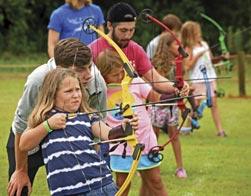
As you can probably tell, kids have a great time at 4-H camp! Camp is not only fun, it is life changing for kids. It is packed with so many opportunities for youth to be leaders, gain independence, be in nature, and so much more! Here are some other reasons why you should consider sending your child to 4-H camp this summer (Provided by the North Carolina 4-H Camps):
For more information on 4-H Camp, please visit our North Carolina 4-H website at https://nc4h.ces.ncsu.edu/campscenters/. There you can find some general information about what to expect at camp and even prices. If you want to sign up for 4-H Camp, make sure to contact your Cooperative Extension 4-H Development Agent as soon as possible. Many spaces have already been reserved so try to get on your county’s list soon! NC Cooperative Extension is an equal opportunity provider and welcomes all to come learn about our programs. Visit ces.ncsu.edu to learn more about NC Cooperative Extension by clicking on the “County Centers” tab and selecting your home county. For more information about Yadkin County 4-H, please contact Madaline Jones at madaline_jones@ncsu.edu or through calling at 336-8497908.
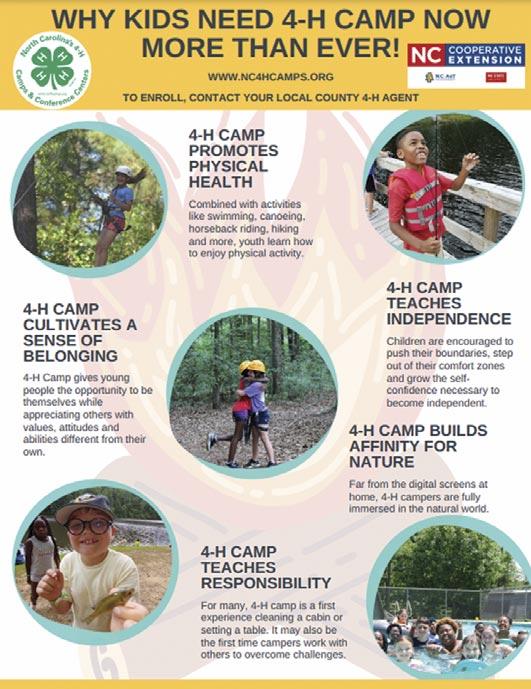
Nineteenth-century naturalist Henry David Thoreau lived more than 800 miles from the mouth of the Yadkin River. But just like Thoreau, the river’s earliest neighbors found spiritual and practical comforts for life in healthy, rippling waters.
Wildlife relied on it, locating their nests and dens near its life-giving force. Area indigenous peoples, the Catawbas and possibly more, used water for all their needs, including making their unique pottery. The earliest white settlers (including, famously, Daniel Boone) sought water to sustain their communities, recognizing it as fundamental to their hunting and agricultural needs.
Today, we know that water is our second most valuable and vital resource, preceded only by the very air that we breathe.
“Who hears the rippling of rivers will not utterly despair of anything.” - Henry David Thoreau

According to the Geneva Environment Network’s global celebration of March 22 as World Water Day, more than 2.2 billion people worldwide live without access to safe water. Burgeoning population growth as well as increasing agricultural and industry needs (and at times, the accompanying pollution) threaten water supplies.
Mankind cannot create the critical element of water, that is, not safely or economically on the large scale on which it is needed. Everyone from communities to countries needs to protect the health of the current water supply.
Here, at and around the Yadkin Basin, many fine people are doing exactly that.
The Yadkin River and its citizens are served well by the Wilkes County Soil and Water Conservation District (SWCD). District Director Kayla Mounce McCoy is passionate about her work, having grown up on a family farm that produced both poultry and beef. She became interested in an agricultural and conservation-related career as a fifth-grader thanks to a Wilkes Soil and Water Conservation Field Day program. Now, in what she calls a “full-circle moment,” she helps oversee that program.
“Farming is hard work, and I grew up wanting to support farmers,” McCoy said in a recent interview at her office. “I always enjoyed learning about the environment and grew
THE YADKIN RIVER BASIN… provides drinking water to nearly 1 million people includes 5,862 miles of streams includes 22,988 acres of lakes needs you to keep it clean!
(Source: Roadmap to a Cleaner Yadkin brochure by Yadkin Riverkeeper)
up wanting to preserve it. I have always loved school and science.” McCoy holds a Bachelors of Science degree in Sustainable Development, a Masters of Arts in Geography from Appalachian State University, and a Soil Science Masters Certificate from North Carolina State University. Wilkes County ranks number one in the state for receiving state funds to assist farmers with best practices. In 2024 and 2025, Wilkes County received $1,080.672.00 state dollars to help Wilkes County farmers with clean water programs. That success is part of the $2.4 million total in grant funds that McCoy has raised since 2019. Grants and gifts made possible the purchase of an exciting and important educational tool, the Mobile Soils Classroom (“It’s like the Magic School Bus,” McCoy said with enthusiasm). McCoy was quick to mention colleagues Norman and 36-year Wilkes County SWCD veteran Barry Greer, the area’s natural resource conservationist, as integral to the fundraising and implementation process.
These resources are critical, as North Carolina has led the nation recently in the loss of farms. Hurricane Helene did not help an already challenging situation.
“Many farmers lost entire fields,” said Wilkes County SWCD Stream Debris Coordinator Makayla Norman.
Large amounts of excess sediment at the Reddies side and at the Greenway Reddies River positions found their way to the bottom of the Yadkin River in North Wilkesboro, McCoy added.
And sediment is a problem.
“Sediment is North Carolina’s number one pollutant,” McCoy said. “Soil needs to stay in its place, in fields. One BMP (Best Management Practice) we encourage is Cover Crops, to cover the soil between crops in the off-season. It helps the water quality by reducing sedimentation and helps the farmer have remaining nutrients for his or her next crop.”
McCoy was eager to praise all efforts. “Soil and water programs are doing more now than ever in soil and water

conservation, and the farmers are doing a phenomenal job,” she said.
The district offers the agricultural community assistance with nutrient management, an Agriculture Cost Share Program ACSP), educational programs for students from elementary school to the community college, and more.
Norman provided information about the StRap program (Streamflow Rehabilitation Assistance Resources Program), an innovative effort responsible in this district for cleaning out 38,230 feet of the Yadkin River.
“From the Kerr Scott Dam spillway to the Ronda park, the Wilkes County Rescue Squad removed 4,285 tons of debris,” Norman smiled.
The Rescue Squad? Four thousand-plus tons of debris?
McCoy and her team secured $800,000.00 in grant funding to clean up the Yadkin River. The district searched for the best contractor on whom to spend that money. The Wilkes Rescue Squad jumped at the chance.
“The Yadkin River is important for fire departments because of water usage,” said Norman, herself a volunteer firefighter and EMT in the Wilbar community.
Frequent kayaking and john-boat accidents due to river debris made clean up high on the Rescue Squad’s radar. They won the bid for the job and removed debris over a two-year period while engaging in a series of water rescue training exercises on the Yadkin.
“It was another funding option for the Rescue Squad and provided them with hands-on training opportunities,” Norman said. “It was a win-win.”
That stretch of the Yadkin is cleaner and safer due to this partnership.
Both McCoy and Norman are FAA and NCDOT Certified Drone Pilots. This skill allows them to provide bird’s eye view photographs and video for farmers, agricultural, and
environmental programs in a fast, safe, and economical manner. Recently, drone footage was critical in evaluating storm damage and erosion issues following the extensive flooding caused by Hurricane Helene.
Logan Haynes, North Carolina Trail Days festival director and community projects and events coordinator with Explore Elkin, NC, serves on Yadkin Riverkeeper’s board of directors.
According to their online mission statement, the non-profit group works to “protect and enhance the Yadkin Pee Dee River basin through education, advocacy and action.” Their goals include ensuring “clean drinking water and a healthy, safe River for the benefit of all the basin’s nearly 3 million residents.”
Haynes, who is involved also with Watershed NOW which he describes as “a small environmental advocacy organization” has a hand both in increasing tourism as well as protecting resources.
“To highlight our home, you’ve got to take care of it,” Haynes wrote in a recent e-mail.
The North Carolina Trail Days weekend, held annually the first weekend in June, includes a river clean-up, information vendor booth, and several paddle trips in collaboration with Yadkin Riverkeeper.
Haynes’ personal love for nature was nourished in his childhood by his proximity to the Yadkin River. After earning a Bachelor’s Degree in Parks, Recreation and Tourism Management from North Carolina State University and a Masters Degree in Conservation Leadership from Colorado State University, he came back
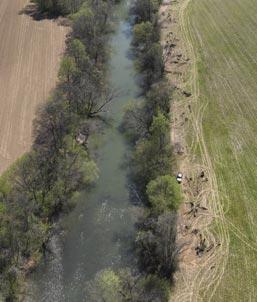
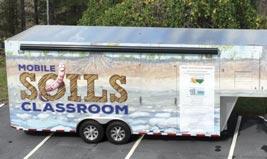
►Get involved. Join a local watershed group, sign a petition, attend a meeting, volunteer.
►Bend a politician’s ear. Make sure they know the environment is important.
►Plant a tree. They slow down rainwater, prevent runoff and absorb carbon dioxide that causes global warming.
►Switch to low-phosphorus dishwasher soap. Less phosphorus in the water means less has to be treated by sewage plants.
►Pick up a local nature book or a book about clean water issues. Ask a librarian for ideas or check out the local interest section of bookstores.
(Source: www.yadkinriverkeeper.com)
to his home town.
“Rivers tell the story of our area, they inform our communities with the most relevant news, and they can shape how we interact with each other,” Haynes wrote. “The Yadkin River is a lifeline that connects us with others across the state. It’s a physical example that demonstrates how a myriad of problems can transcend boundaries, just as success and collaboration with each other can, too. The hum of a river really is one of the wisest voices.”
Haynes describes himself as “overall very hopeful” about the future of Yadkin River conservation. Recently, he aligned himself with Watershed NOW/Friends of Big Elkin Creek, a group to protect and restore the 35-square acre watershed in the body which is a tributary of the Yadkin River. He serves as Watershed Protection Coordinator. He has traveled widely, and his professional experience includes stints with the U. S. Forest Service, AmeriCorps, and environmental education.
“You don’t just clock in, contribute eight hours, and clock out with this line of work; you live your life around this kind of work,” Haynes wrote. “I’m thrilled to be a conservationist for my community, and hope to leave a foundation to guide it with.”
“The greatest thing we can do as conservationists, especially those of us who engage the public often, is share the opportunity for anyone to help and make a difference,” he wrote. “Conservation of the Yadkin River won't be done exclusively by a few groups of environmentalists alone, quite the opposite. Spreading awareness and letting everyone know they have a role to play that's meaningful is the route to take. There are plenty of battles ahead, but instead of actively seeking quarrels with some and scaring others, we can empower so many audiences and inspire people.”
Lisa Brewer is the Executive Director of Carolina Bible Camp Bluegrass Festival in Mocksville, NC. She lives in Wilkesboro with her husband, Greg, and their rescue dog, Biscuit, who loves to dip her paws in the Yadkin River.
•“Lord, We’re Just Trying to Save Your Water”: Environmental Activism and Dissent in the Appalachian South by Suzanne Marshall. If you are looking for a scholarly book about water conservation beyond the Yadkin River, this is a good one.
•Saving the Wild South: The Fight for Native Plants on the Brink of Extinction by Georgann Eubanks. This book’s first chapter is about a rare kind of Goldenrod found along the Yadkin River.
•Yadkin Passage by Floyd Rogers and A Voyage Down the Yadkin-Great Peedee River by Douglas L. Rights. Rogers was a popular Winston-Salem Journal reporter who made his trip with friends in 1982. Rights and his partners traveled in 1925. His language is charmingly quaint in spots but employs distasteful racial labels of his era in others. Both titles are published together in a single, out-of-print volume and provide an up-close look at adventures on the Yadkin River.
•Yadkin Pee-Dee River Basin Plan: Level B Comprehensive Water Resources Study, produced by the States of North and South Carolina, and the U. S. Water Resources Council in August, 1981.
•Be sure to visit the offices of the Wilkes Soil & Water Conservation District at 416 Executive Drive, Suite A, in Wilkesboro, for the excellent information available free in brochure form.
At Aesthetix Laser and Medspa , we believe in the power of self-care and transformation. Our mission is to help you look and feel your absolute best through cutting-edge treatments, personalized care, and a luxurious experience that rejuvenates both body and mind.
Our team of licensed medical professionals offers a variety of customized services including:
●Neurotoxin and Dermal Fillers
●Laser Hair Removal
●IPL - photofacials
●Frax
●Microneedling
●RF Microneedling
●Hair Restoration
● Anteage and Revision skin care products
● Hydration
A Transformation Awaits
When you visit Aesthetix Laser and Medspa you’re not just receiving treatments—you’re embarking on a journey to enhanced confidence and well-being. Whether you’re looking to refresh, tighten or tone your skin, or simply relax, we’re here to make it happen.

Ready to start your journey? Consultations are complimentary!
Contact us at 336-409-0241 or visit our website www.aesthetixlaserandmedspa.com to schedule your appointment. Follow us on @aesthetixlaserandmedspa_pllc for the latest updates, tips, and specials.


Let us celebrate you! Book Your Appointment and mention this ad for 20% off your first treatment as a new client. Don’t miss the chance to begin your transformation today!

Aesthetix Laser and Medspa: Where Beauty Meets Science, and Confidence Comes Naturally.
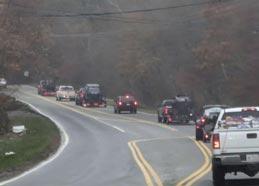
On September 14, 2018, Hurricane Florence changed our lives forever. At the time, our family—me, my husband, and our five children—had only been living in our Wilmington home on the Cape Fear River for 28 days. When the mandatory evacuation order came, we each packed a bag as best we could and left, not knowing we would never return. The hurricane completely destroyed our home. With no flood insurance, we lost everything we owned.
We were displaced, terrified, and uncertain about our future. At times, we were even separated from one another. That fear and instability never leaves you—and it’s why we feel such a deep connection to the families now suffering in the mountains from the aftermath of Hurricane Helene. Though we endured our own loss, it pales in comparison to what many in these remote areas are still going through. We understand their fear because we’ve lived it, and that is what fuels our mission to help them—week after week, and for as long as they need us.
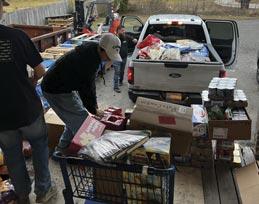
Editor’s note: Last September, before the rain from Helene had even stopped falling, we began to learn of the devastation in western North Carolina and other areas of the southeast. Organizations, businesses, churches and individuals began to collect water, food, and other basic necessities. Volunteers with four-wheel drives, UTVs, and chainsaws were in demand as there were not nearly enough rescuers for all who needed rescuing. The Yadkin Valley, along with other areas, stepped up and helped to answer that immediate need for help.
If you follow Yadkin Valley Magazine on Facebook, over the last seven months you have seen me share posts from Mike and Anna Southern of Yadkinville. They were among the first to start collecting supplies and organizing volunteers to help folks in Avery County. They are different, though, because seven months later, they haven’t stopped. They are still collecting supplies. They are still organizing volunteers. They are still helping those who need them. They are People Helping People, and the story starts with them. Hopefully, you will help continue that story.

Out of our personal experience, People Helping People was born. What started with an enclosed trailer delivering essentials after Hurricane Helene has grown into something so much bigger. We now operate a warehouse and have recently been blessed with a building that once belonged to another nonprofit. A woman found me through Facebook, felt it was her calling to help, and donated her entire store setup—racks, shopping carts, everything.
We’re turning that space into a unique community resource. It will serve as both a free store—where hurricane survivors & people in need, especially children, can shop for food, clothing, and hygiene items—and a retail store, where handmade crafts and donated goods will be sold. 100% of the profits from retail sales will go directly toward aiding those in need and helping families rebuild their lives.
We’re also creating a large food pantry and essentials area to ensure no one goes without. This space will be full of heart, because that’s who we are—People Helping People. We’re in it for the long haul.
The devastation caused by Hurricane Helene isn’t just measured in property—it’s measured in people. In lives uprooted, families shattered, and silent suffering that still echoes through the mountains.
Two men—I’ll call them A & T—were sitting on their porch when we found them-hungry, thirsty, and completely cut off from help. Their only bridge to the outside world was washed away when their quiet stream turned into a raging river, sweeping the bridge and their vehicle away in seconds. What was once their yard is now just a narrow ledge on the brink of collapse. We were the first to reach them. With ropes and determination, we crossed the water and delivered the essentials they so desperately needed.
Then there’s Bear. He lives alone with the memory of his late wife and the deep bond he shared with his 15+ hunting dogs. When the hurricane hit, three landslides surrounded his home—one behind and one on each side. The slide behind his house shifted it nine feet off its foundation. From his kitchen window, he watched helplessly as a landslide buried his dogs and swept away his farm equipment. It’s a loss that goes beyond what words can describe.
And there are countless others:
A woman found 48 hours after the storm, clinging to life on a mattress, unclothed and freezing in a tree.
An elderly couple and their daughter sitting beneath a tarp where their home once stood.
A car washed away with a couple inside, their story ending before help could ever arrive.
We carry these stories with us. Each one is a reminder of why we show up week after week. Why this mission is personal. These aren’t just stories of tragedy—they’re stories of survival. And every single person we’ve met deserves to be seen, heard, and helped
Make a donation: cash is best so the greatest need at the time can be met, but donations of non-perishable food, hygiene items, cleaning supplies, and pet food are always accepted. If there is a special or urgent need, it will be communicated on Facebook.
Volunteer: volunteers are needed to help unload trailers, sort donations and repack/load items to be delivered. The retail space will be run by vounteers, too.
Share: Share this story and the work of People Helping People so that the situation in the mountains is not forgotten.

As time goes on, the needs of the people we serve in the mountains continue to evolve—but the struggle remains just as real. Now, as the weather warms, they’re facing new challenges: access to clean drinking water, the need for fans to stay cool, and summer clothes and shoes for their children.
But it’s not just about the season—it’s about survival. Jobs have been lost, and even those who are working can’t keep up. The cost of living has skyrocketed. Insurance rates, power bills, and grocery prices are climbing beyond reach. These families are forced to make heartbreaking choices—pay a bill or feed their children. Buy pet food or keep the lights on.
Every week, we deliver more than supplies—we deliver hope. Many of them tell us we are their lifeline. And we take that to heart. Our mission isn’t temporary. It’s rooted in compassion, and it’s growing to meet the rising needs, one family at a time.
Article and photos courtesy of Anna Southern.
Facing page: Convoy of supplies en route to Avery County, devastated church, loading supplies at the warehouse.
Above: delivering supplies to a home that was completely cut off by storm damage.
Page 12 (upper left corner): Mike & Anna Southern with some of the volunteers who make up People Helping People.
See more photos at yadkinvalleymagazine.com.
The Writers Road Show Author Tour brought book lovers together during National Library Week to meet authors, talk about books, and encourage reading and writing in the region.
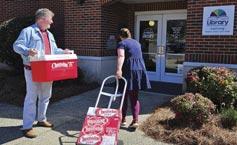
The South’s Unique Cherry Soft Drink at all Tour events, sponsored by Cheerwine. Thanks to Glenn Parker for picking up the donated drinks, assisted by Melanie Johnson, (doing heavy lifting) King Assistant Branch Manager

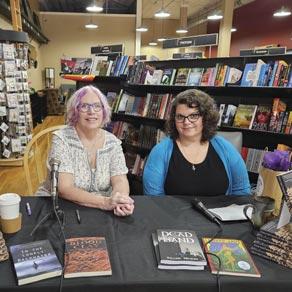
Valerie Nieman, author of Upon the Corner of the Moon, kicked off the week’s events at Pages Books & Coffee. Released in March, Val’s newest book tells the story of the historical Macbeths. Pictured with Val is Cynthia Taylor, owner of Pages.
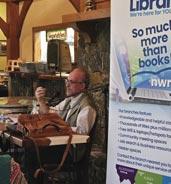
at Sanders Ridge Vineyard & Winery, Dale Neal shares some of the research required for writing his historical fiction novel The Woman with The Stone Knife.

Dale Neal continued the Authors Tour with a writer’s workshop at the Danbury Public Library. In addition to the workshops, his events included book talks and coffee & conversation. He made an appearance in each county served by the Northwestern Regional Library!
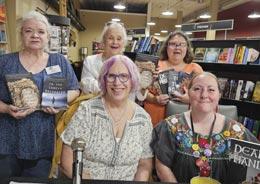
Librarians with guest author, Valerie Nieman at Pages Books & Coffee on April 6. L-R Anna Nichols, Regional Manager Joan Sherif, Valerie Nieman, Rana Southern, Emily Morgan
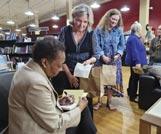
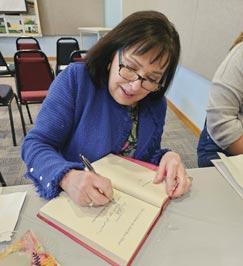
Susan Zurenda signs a copy of The Girl from the Red Rose Motel following her book talk at the Elkin Public Library. Readers also had a chance to spend time in conversation with her at Pages. Her experience as a high school teacher led her to write this contemporary novel with a homeless teenager as a central character.
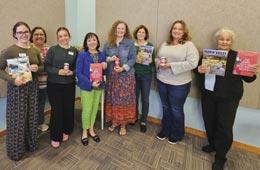
Staff/supporters of the Elkin Public Library with author. L-R: Abby Walker, Carolina Del Moral, Cassidy Transou, Susan Zurenda, Leath Henderson, Karen Alley, Lee Villiers, and Joan Sherif


The tour finale at Pages Books & Coffeee featured Winston- Salem native Charlie Lovett, author of Escaping Dreamland, with cookbook author Chef Belinda Smith-Sullivan who also calls Winston-Salem home. The March-April issue of Yadkin Valley Magazine included the recipe for Chef B’s Citrus- Champagne Sangria from her newest book, Cocktails Southern Style.
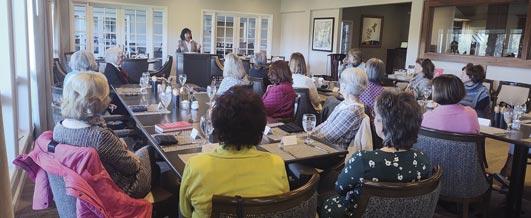
As authors follow the Readers Trail through our region, more readers are getting together and sharing their favorite books. Book club gatherings are the perfect place for this to happen. During the Writers Road Show, the Ridge Readers Book Club in Alleghany County hosted a lunch with Susan Zurenda as special guest. Club members could invite guests, and all together, four of the county’s book clubs were represented. Talking about your favorite book is a way to connect with friends and find folks with similar interests and tastes in reading. Here are some ways to make the conversation more engaging and enjoyable.
1. Share how you found the book and where, (on the library shelf, through Hoopla or another NWRL online service, a bookstore, audiobook, etc.
2. Talk about what you especially like about the book. Is it the plot, or the characters, or maybe it’s the writing style?
3. Encourage a deeper conversation with open-ended questions. Ask questions like, “What do you think would have happened if……”
4. Make connections between themes from the book and personal experiences or current events to enrich the discussion with diverse viewpoints.
5. Accept that not everyone will share your enthusiasm. Keep an open mind. Agree to disagree.
6. If you sense some interest, propose reading the book together. Shared reading can deepen friendships and spark even more engaging discussions. Meet at your local library or gather at a nearby coffee shop or community center.
Get out there and talk about your favorite books! Broaden the conversation about stories and the people who write them.
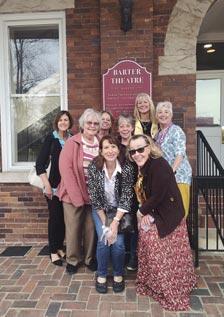
By Jennifer Moorman
Learning that Jennifer Moorman was coming to Pages Books & Coffee with her latest novel, The Vanishing of Josephine Reynolds, I picked up a copy. I have never been an avid reader of time-travel novels, but I did enjoy The Time Traveler’s Wife when it came up as a selection for book club.
Reading the back cover I discovered the main character was a 35 year old widow. It made me wonder…would her future turn out to be a clean slate or an empty void? When your world revolves around one person, and suddenly that person is gone, who are you? After just a few pages I related to Josephine and wanted to share her journey.
The story follows Josephine Reynolds, a 35-year-old widow, engulfed in grief, who impulsively wishes she had never been born—a wish that unexpectedly alters her reality. When she stumbles upon her ancestral home in Nashville, she goes all in. While searching for furnishings, she finds and installs the original door. When she steps through, Josephine is transported back to 1927, where she encounters her great-grandmother, Alma, a young widow running a secret speakeasy during Prohibition. Josephine sees the world through Alma’s eyes and is entranced.
Set against the backdrop of the Jazz Age, the novel travels back and forth in time. It immerses the reader in the vibrant culture of the 1920’s, from clandestine speakeasies to the challenges of Prohibition. It provides a contrast to Josephine's contemporary life and emphasizes the timeless nature of certain struggles and joys. As she explores this past point in time, she builds friendships and even finds a new love interest. But, as Josephine’s existence begins to disappear, she realizes she must race against time to rewrite history. Alma’s life is in danger, and it’s up to Josephine to save her, and save herself in the process.
This novel is a well-written blend of magical realism, historical fiction, and personal discovery that offers an entertaining read and rich material for book club discussions. Can you remember Kate & Leopold, the 2001 movie with Hugh Jackman and Meg Ryan? Josephine would appreciate that movie! She could definitely relate!





Kellee Payne
Kellee Payne
Commercial and Consumer
Horticulture Agent
N.C. Cooperative Extension
Yadkin County Center
kellee_payne@ncsu.edu
Facebook @YadkinCountyHorticulture
If you're a hummingbird enthusiast, you'll be thrilled to know that hummingbirds are making their annual spring journey back from Mexico and Central America to North America for breeding. Can you believe these tiny birds weigh as much as just one penny? Despite their small size, hummingbirds are important pollinators, climate change indicators, and insect population regulators.Hummingbirds journey over 2,000 miles while facing a multitude of weather conditions. A typical daily flight involves traveling 23 miles at speeds ranging from 30 to 60 miles per hour.
Although hummingbirds primarily rely on nectar for sustenance, they are also opportunistic feeders, consuming spiders, insects, and tree sap. This diverse diet is particularly important during the breeding season, when the protein from these sources is vital for the growth of their young. Living a fastpaced life, hummingbirds will enter a state of lethargy to conserve energy by slowing their metabolism and lowering their body temperature when faced with environmental challenges.
The United States is home to many hummingbird species, including the Ruby-throated, Anna’s, Black-chinned, Calliope, Broad-tailed, Allen’s, Whiteeared, Rufous, Broad-billed, Buff-bellied, Violet-crowned, Lucifer, Bluethroated, Costa’s, and Rivoli’s.
Do you want to attract hummingbirds to your landscape? The key to attracting hummingbirds to your space is to provide food and shelter through native plant species. Whether you have a small patch, or a large dedicated space, can make a difference; by planting the right species, you'll bring hummingbirds to your yard with essential caterpillar hosts and nectar. Pick a site in a sunny location, as hummingbirds are particularly drawn to these areas. You will also want to plant your garden in a spot that's protected from the wind, like next to a fence or building. Conduct a soil test of the site to ensure success. To effectively establish your habitat, sketch a garden plan showing the organized placement of nectar and host plants, water sources, basking areas, and any required feeder sites. Fall is the best time to plant hummingbird habitats, using native perennials to avoid annual replanting.
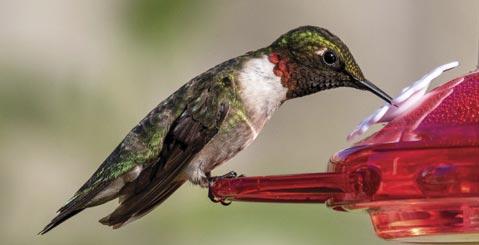
Choose plants that boast red or vividly colored flowers, as these are especially appealing to hummingbirds. Incorporate trees and shrubs into the landscape to provide essential perching and nesting areas.
Attract Hummingbirds with These Plants:
Trees: Red buckeye, hawthorn, yellow buckeye, yellow-poplar
Shrubs: Buttonbush, mountain laurel, rhododendron, sweet pepperbush, wild azalea
Vines: Crossvine, coral honeysuckle, Carolina jessamine, trumpet vine
Flowers: Beebalm, blue lobelia, blue phlox, cardinal flower, columbine, crested iris, fire pink, horsemint, jewelweed, rose mallow, smooth beardtongue, sundrops, wild bergamot, yellow thistle
Feeding Tips
In your hummingbird feeders, use a 4:1 mixture of water and white granulated sugar. Prepare the food by dissolving sugar in hot tap water and allow it to cool. Store any remaining solution in the refrigerator. Avoid using honey, brown sugar, fruit juice, or red dye, as these substances can easily spoil and pose a risk to the birds'
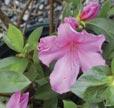
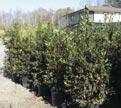

health. To maximize hummingbird visits, station feeds in proximity to nectar sources. Protect hummingbirds by avoiding all insect sprays, repellents, and pesticides around their feeders. To keep ants and stinging insects away from the sugar solution, apply petroleum jelly to the hanging wire. Clean your feeders once a week with hot water and vinegar.
Happy Hummingbird Watching!
To learn more about hummingbirds, visit the references below:
Hummingbirds of North America, U.S. Fish & Wildlife Service: https://www.fws.gov/story/hummingbirds-northamerica
Hummingbirds and Butterflies-Working with Wildlife, NC State Extension: https://content.ces.ncsu.edu/hummingbirds-and-butterflies
Our office is an equal opportunity provider, so if you have any questions related to horticulture, please contact Kellee Payne at kellee_payne@ncsu.edu or 336-849-7908.

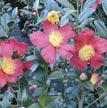

Spring...time to brighten up your yard with new plants and lots of color! At Joe’s we carry... a large selection of tree and shrubs... a complete line of soil amendments... pine needles, mulch and bark... grass seed and fertilizers for yard and shrubbery beds. Don’t miss our Encore Azaleas!

Family owned and operated
705 Lasley Road, Lewisville 336-766-6513

Monday-Friday 7:30-4:00 Saturday 8:00-12:00

Leslie Rose

Leslie Rose
Extension Horticulture Agent Director of the Arboretum at Tanglewood Park
leslie_rose@ncsu.edu
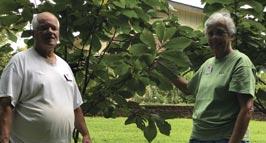
On most Tuesday mornings at the Forsyth County Demonstration Garden, you can find a group of NC State Extension Master Gardener volunteers working in the garden. These volunteers freely share their time and expertise to help other community members learn about gardening and they are essential to the work of North Carolina Cooperative Extension. The volunteers swap plants and stories, while helping with a variety of garden maintenance tasks and assisting at educational events.
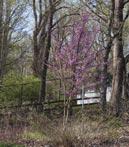
One of our dedicated Demonstration Garden volunteers is Pattie Sacrinty, who has spent her whole life in the Yadkin Valley. Pattie credits her family history of farming for instilling a love of gardening in her from a young age. “My first experience was raising tobacco, and we always had a garden.” While Pattie is retired from a career in nursing, she still has family members who farm. Over time, their tobacco farms have diversified to include other streams of income, including soybeans and beef cattle.
Eastern redbud (Cercis canadensis) is one of the first plants to bloom during spring in the Piedmont of North Carolina.
Pattie’s love for gardening and for the Yadkin Valley
region are tied closely together.
“I love the variety of plants you can grow here,” she said. While she enjoys snow in the winter, Pattie lights up when she talks about springtime and the flowers that come with it. “I look for the Eastern redbuds–that to me is the first sign of spring.”
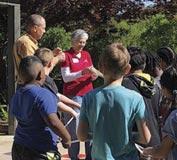
After seeing N.C. Cooperative Extension’s displays at local home and garden shows and attending classes taught by Extension Agents, Pattie completed her Extension Master Gardener volunteer training in 2019. Pattie is a regular volunteer in the Demonstration Garden, but helps Extension in many other ways. Pattie assists with the annual Pawpaw Field Day, offering tours of the pawpaw orchard to visitors. She also mentors new volunteers and serves on Extension’s advisory council. Pattie’s favorite volunteer activity is assisting with Youth Education, where third grade students visit the Arboretum at Tanglewood Park to learn about plant science.
Pattie brings her knowledge to her community, including designing and maintaining gardens at her church. In addition, Pattie now spends time gardening with her grandchildren and teaching them how to care for the environment. Pattie said, “I wish people knew that what’s offered at Extension supports quality of life. Master Gardener is not just a class, it’s a life skill. It teaches you skills you carry with you.”


A Pollinator paradise or butterfly garden is WITHIN YOUR REACH. Imagine stepping into your backyard and being greeted by the gentle flutter of butterfly wings, the buzz of bees, and the colors of blooming flowers. It's not a fantasy – creating a thriving pollinator paradise is achievable, and it's essential for our ecosystem. With our diverse climate in North Carolina, we have a unique opportunity to support these vital creatures.
Pollinators, including bees, butterflies, moths, hummingbirds, and beetles, are crucial for the reproduction of many plants, including our food crops. Without them, we'd see a dramatic decline in fruits, vegetables, and seeds. Recent studies have shown that the decline in pollinators has a direct impact on our local ecosystems and agricultural sustainability.
We have plenty of plants with nectar that can help all of these creatures pollinate. By creating a pollinator-friendly garden, you're not just adding beauty; you're playing a vital role in their survival, helping ensure our local food systems continue to thrive. To attract a diverse range of pollinators, it's essential to plant a variety of flowers that bloom throughout the growing season. Let's explore how you can make a difference. Here are some excellent choices for North Carolina gardens:
Black-eyed Susans are a native flowering perennial that requires fertile soil that drains well to flourish. They bloom abundantly from summer into fall, reaching a height of 2-3 feet. We’d suggest Daddy Pete’s Planting Mix for inground plantings and Daddy Pete’s Potting Mix if you intend to put them in a planter. Black-Eyed Susans enjoy full sun most and can still prosper under part shade. At Mitchell's Nursery, we have a variety of black-eyed Susans called Goldstrum’s Select, a resilient variety that will help with pollination. Beware of double varieties; they’re inaccessible to pollinators! These are such a bright addition to any pollinator paradise.
Joe Pye Weed is a well-known North Carolina pollinator plant with the most beautiful fuchsia blooms. Butterflies, bees, and other pollinators love this Carolina native! It thrives in moist, rich soil and does well in full sun to partial shade. It is partial to regular, deep waterings. Pye Weed blooms in late summer and early fall, providing a lateseason food source for pollinators. It can grow quite tall, reaching 3-4 feet, so plan accordingly in your garden design. Spreading mulch will help the soil retain moisture. Older plants, after several growing seasons, can be divided and replanted in early spring.
Hellebores put on a show during the winter months when not much else is blooming. These tough plants survive in shade, which makes them desirable for tricky spots. This plant attracts plenty of pollinators at a time when resources are scarce. You can expect hardy bee-loving blooms that can come back every year.
Phlox is a flowering perennial that many southerners enjoy. It is considered a butterfly garden staple. Phlox are excellent pollinator plants and add bright pops of color to any garden, planter, or porch front. They do well in full sun with lots of watering and partial sun with less watering. If you are growing them in an area with partial sun, try cutting them back in late spring to discourage stretching, which leads to leggy, weak plants.
Bee balm is my personal favorite on this list because I have seen its effectiveness in attracting bees, butterflies, and hummingbirds. It offers a unique bloom and color. It enjoys full sun to partial shade. It will find happiness in moderately fertile, humus-rich soil that is moist but welldraining, and pollinators will find their paradise there.
Also known as Buddleia, it is a summer and fall flowering shrub that attracts butterflies (of course), hummingbirds, and bees. It prefers full sun in well-draining soil and should be severely pruned during the winter. Buddleia smells fantastic and is perfect for planting in front of the porch, where you can watch the butterflies enjoy themselves!
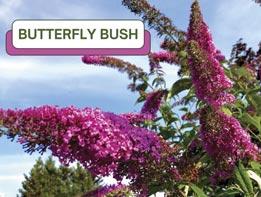
Azaleas are a wonderful sight to see in April when they burst to life! They supply nourishing nectar to butterflies and hummingbirds! Azalea comes from the Greek word azaleos, which means “dry.” Azaleas don’t like having their roots perpetually moist, as it leads to rot. It’s best to water azaleas infrequently but deeply and stick to a schedule. They thrive in partial shade and do best in acidic soil, which we have plenty of here in North Carolina clay. Pine needles can help provide more nutrients and acidity, as well as mulch, which will absorb some of the moisture that azaleas don’t like.
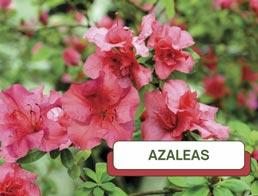
Pycnanthemum is a great pollinating perennial. It is not the showiest plant, but pollinators love it. A North American Native, Mountain Mint grows slowly and provides plenty of blooms for insects and other pollinators to enjoy. As a low-maintenance perennial mountain mint, it is only watered until it is established. Afterward, let them be and trim them back in the spring to keep them from overpowering other crops. Honeybees, Bumblebees, butterflies, and many other pollinators adore this lowmaintenance perennial.
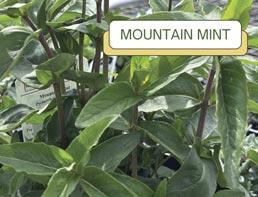
Parsley serves a vital role for a specific species of butterfly! Eastern Black Swallowtail Butterflies love to lay eggs on parsley. They hatch out into the prettiest greenstriped caterpillars and eat the parsley. So remember to plant enough parsley for you and the caterpillars. Parsley must be planted in nutrient-rich, well-draining soil after the last frost (April 15th). They thrive in both partial shade and full sun. Water when the top inch of soil becomes dry! Butterflies, beetles, and bees will thank you.
Butterfly Weed is not much of a weed as it is a native wildflower. Serving as a vital role, this is the only host plant for the monarch butterfly! Milkweed is droughttolerant. It thrives in well-drained, sandy soils, making it a perfect choice for those extra sunny spots in your garden.
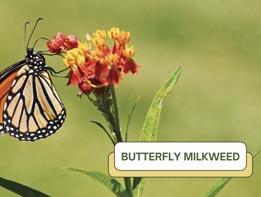
►Water Sources: Provide shallow dishes of water with stones for bees to land on.
►Shelter: Leave some areas with undisturbed soil and leaf litter for ground-nesting insects.
►Avoid Pesticides: Use natural pest control methods to protect pollinators.
►Seasonal Blooms: Ensure your garden has plants blooming throughout the growing season.
►Plant in Groups: Grouping plants of the same species makes it easier for pollinators to find them.
Not only is a pollinator paradise beautiful, but by planting pollinator plants, you will be helping the environment and helping yourself to a more sustainable landscape! So, plant a pollinator paradise this spring that will have your lawn more like a meadow or prairie. Happy Growing!

The schedule is too packed to print here, but there is really something for everyone. Like long hikes? Try the Mountains to Sea Trail. Leisurely stroll more your thing? Do the Downtown Elkin Historic Hike. There are bike trails, paddle trails, and dog-friendly trails.
Each day information will be available from 9 am4 pm at the Yadkin Valley Heritage and Trails Visitor Center, or you can plan your Trail Day adventures at nctraildays.com
Join us for the 6th annual North Carolina Trail Days in the towns of Elkin and Jonesville - home of three great state trails! The festival celebrates the great outdoors and recreation culture found in the Blue Ridge foothills. Highlighted are a collection of local trails, Segment 6 of the NC Mountains-to-Sea Trail, and a variety of activities and adventures all weekend! NC Trail Days is always held on the weekend aligning with with National Trails Day - the first Saturday in June.
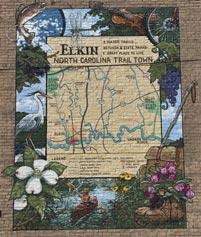
Bring your boots, bikes and boats (kayaks) to enjoy the weekend with trail lovers from all over. Festival offerings include themed and self-guided hikes, river clean-ups and excursions on the Yadkin, group rock climbing, a Thursday kickoff and Friday evening block party, environmental and adventure film screenings, tons of free live music, kids activities, speaker series and not to mention a vendor village full of outdoor recreation organizations with gear demos and an overland vehicle showcase.
Visit 3 Great State Trails, 2 Great State Parks and 2 Great Towns!
Elkin and Jonesville are separated only by the Yadkin River and are at the confluence of three great state trails: the NC Mountains-to-Sea Trail, the Overmountain Victory National Historic Trail, and the Yadkin River State Trail. Additionally, both have an ever-growing network of trails with unique history like the Elkin & Alleghany Rail Trail and Jonesville Greenway. Several have exciting themes including NC's first 'Forest Bathing' Trail, several birding trails, the Yadkin Valley Wine Trail and first-class road and mountain bike trails. That's just to name several! We are located just below the Blue Ridge Parkway and between two Stone Mountain and Pilot Mountain State Parks which offer exceptional rock climbing, fishing and camping opportunities. If it's outdoor recreation variety that you're seeking, you'll find it here!
NC Trail Days is our way of celebrating this beautiful region and we encourage you to come find your trail.
In the continuing series on the Yadkin River, Lisa Brewer’s article (page 46) highlights the efforts that are going into the protection and preservation of this vital resource. A photo of the river was not my original plan for the cover of this issue, but when I saw this one, I thought it needed to be shared.
Thanks to Makayla Norman, formerly the Wilkes County Soil and Water Conservation District Stream Debris Coordinator, for sharing this and other river photos for this issue.

Join Yadkin Riverkeeper (YRK), the Elkin Trails Association, and other volunteers to remove debris from our Yadkin River while paddling from Crater Park to Burch (about 6 miles) near the confluence of the Yadkin and Mitchell Rivers. Registration is recommended for this event. YRK may be able to provide a limited number of boats to volunteers, but we are encouraging volunteers to BYO boat. Paddlers will meet @ Crater Park for lunch, drive to Burch to drop off vehicles and shuttle back to Crater to put-in. Volunteers will receive a free lunch. More available at https://www.yadkinriverkeeper.org/












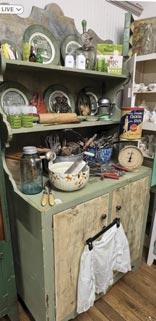

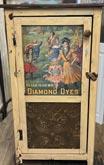
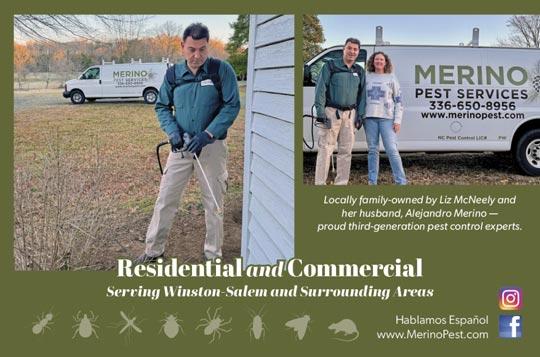











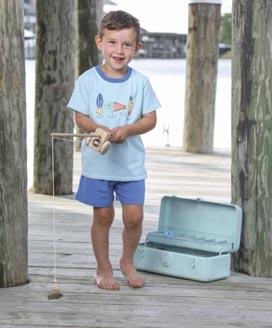






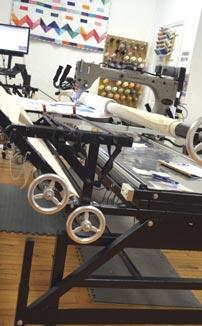

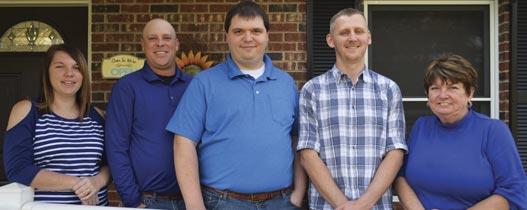


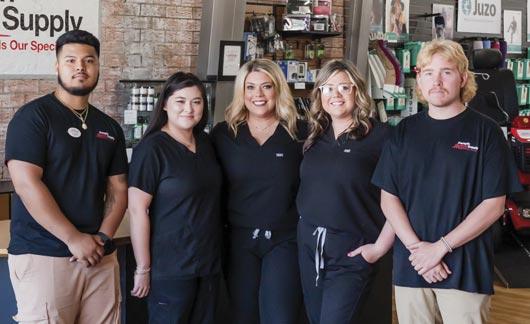

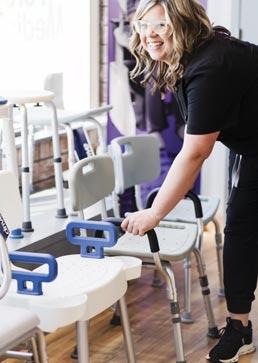




Largest


Offering
Supplies and Equipment
Bathroom Aids & Safety
Sanitation and Deodorizers
Beds & Accessories
Braces, Splints & Slings
Custom Fit Compression Garments
Daily Living Aids
Health Monitors
Mobility Aids & Equipment
Occupational & Physical Therapy Aids
Surgical Supplies Just
Manual Wheelchairs Hospital Beds
Electric Scooters Knee Walkers Lift Chairs
Hospital Medical Supplies
Home Medical Equipment
Discount Medical Supplies
Wound Care Products
Gloves, Nebulizer, Bariatric Equipment
Bathroom Safety Aids, Orthopedic Products, Ostomy Supplies
Respiratory, Urological/Catheters
Walking Aids & Wheelchairs




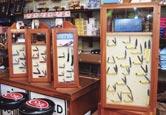
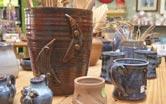








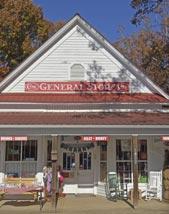
Saturday, May 17
11 am - 5 pm

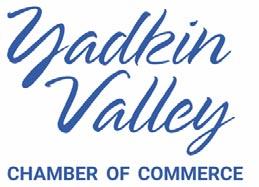

The Yadkin Valley Chamber of Commerce proudly serves the business community in Surry, Wilkes and Yadkin Counties. Other organizations who strive to improve the communities served or to improve economic development in the area are also welcome to join the chamber.
Over the past five years, membership in the Yadkin Valley Chamber of Commerce has grown considerably. Businesses and other organizations benefit from a strong chamber! When callers request information about local businesses, chamber members are always prioritized. The chamber website is also a resource for those looking for information about local businesses.
Potential members should contact David Steelman at president@yadkinvalley.org

May 17 Yadkin Valley Wine Festival
June 13-14 Yadkin Valley Carnival
September 27 Yadkin Valley Pumpkin Festival
July 25-27 Take a Break from the Interstate
December 5 Gingerbread House Contest at Light Up Elkin Event
December 14 Yadkin Valley Christmas Parade
It helps you make business contacts. When you decide to join a local chamber, you open your business to a network of potential partnerships. It increases your credibility. Joining your local chamber of commerce could give you more credibility with potential customers. It increases your visibility.
As your local chamber continues to grow, so will your visibility in the community. While the types of events will vary, each will allow you to make new connections and gain exposure for your business. Once a month you are able to highlight your company on our newsletter, website and social media platforms. Which means if you have a particular month that you are slow...we could absolutely help ramp up some business for you to fill those empty spaces.
It supports your professional development. In addition to networking events, we hold events and training sessions focusing on professional development. These opportunities are affordable (most of the time free) ways to improve your skills and increase your knowledge. The chamber’s professional development opportunities will help your business make necessary changes and share its expertise with others.
There are many volunteer opportunities at the events hosted by the Yadkin Valley Chamber of Commerce. You do not have to be a member of the chamber to make a difference! If you would like more information, contact Quinn Wilkins. info@yadkinvalley.org


September 27, 2025 9 am - 4 pm
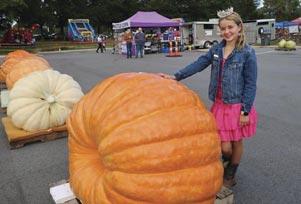
I remember the first time that I met Chris Brown. At a fundraiser for a local family, Chris auctioned off to the highest bidder the chance to cut off his rattail. Yes, rattail. The 80s hairstyle that caused many an argument between parents and teenagers. Except it wasn’t the 80s anymore, and Chris was no longer a teenager. But a rattail he had, and though I don’t recall the winning bid, he parted with his rattail to benefit a family in need.
If you have known Chris for very long, you might not have predicted that he would wind up leading a kids ministry. But if you have known Chris for very long, you probably aren’t too surprised, either. He has a heart for helping others, and a patience with kids that even he didn’t know he had.
In 2020, in an effort to give kids at his church something to do while the pandemic shut down other activities, he began teaching a few teenage boys how to work on a go kart in his garage. He quickly learned that he had to teach them the basics, starting with tools. He could not assume that kids grew up like him, working on cars every chance they had.
That first group of seven or eight kids had one kart. That grew to three karts. The next year a ten year old showed up, then brought a friend. A Cruise-in fundraiser brought even more, and now Chris had a building full of kids and karts. He didn’t just have teenage boys now, the kids were getting younger and some girls joined in. Which meant Chris had to re-learn how to teach this younger age group.
Last year, drivers ranged from six to seventeen years
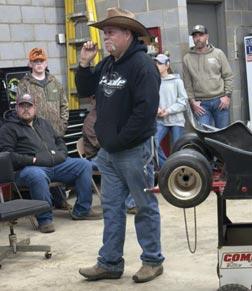
old. Chris had up to eighteen karts. Due to space concerns-there just wasn’t room for all of those karts and people in his shop-he began selling the karts to kids at the end of the season if they planned to continue racing. That way, kids and parents got a year’s worth of kart

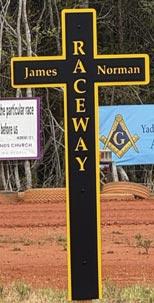
mechanics and racing experience before making a big investment. Chris keeps the number of kids and karts more manageable. This year’s season was just gettting started when I visited with Chris and his crew a few weeks ago. God’s Garage was still full.
But the finish line on the race track isn’t the only goal here. Chris wants the kids he works with to learn skills and have fun racing, but he wants them to also run the race of life with Christian purpose. Friday nights at God’s garage include a devotion for everyone and a Bible study for the kids. There is food and fellowship in addition to wrenches and racing tips. For the fathers, grandfathers, and other male volunteers, there is a weeknight Bible study, with plans to add one for the ladies, too.
God’s Garage truly is a family and community affair. A gentleman whose grandson raced previously comes back

This year’s season is just beginning. These kids attended a recent Friday night at God’s Garage. Some are drivers, some are siblings who tagged along. When one youngster learned that I was there to get information for a magazine article about Chris, he summed it up nicely: “Chris is awesome!”
to volunteer in the gargage. A previous racing kid does, too. At the first race of the 2025 season, racers ranged from age three to seventy-three, including a kid and his grandfather.
God’s Garage has the support of Chris’s family, too. His wife, Twinkle, makes sure that there is enough food to feed the small army on Friday nights, and coordinates concessions for Saturday races. Chris shared his appreciation for his late cousin, Barry Forest. Barry’s generosity has provided a larger space for kids and go karts at God’s Garage.
Chris’s pre-race instructions include the necessary safety reminders (this ain’t bumper cars, he tells them), but he also reminds them to show Christ-like sportsmanship, and to let the Son shine through them.
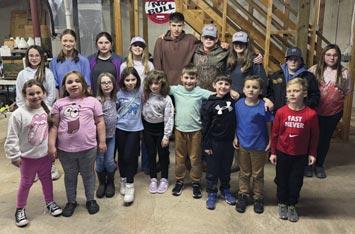
��Pray for the ministry of God’s Garage.
��Attend a race and cheer these kids on.
(Admission is free, and so are concessions, though donations are accepted.)
��Attend a Friday night fellowship at God’s Garagevolunteers and visitors are always welcome.
��Make a donation to support this ministry.
��Follow on Facebook to keep up with events.
Chris Brown (336) 244-3289
JAMES NORMAN Raceway 2025 schedule
May 10.
May 24.
June 14.
July 12.
July 26 Ironman 15 & under. August 23.
September 13. September 27. October 11.
All races are planned to start at 4pm Dates are subject to change




Most of the time, a flat tire is at best an inconvenience. It doesn’t usually pave the way for a successful business. This Mock family legend survives, but the name of the gentleman whose tire it was is long forgotten. But that very thankful person paid two teenage Mock brothers one dollar for changing his tire on a Forsyth County dirt road. For farm boys in the middle of the last century, that was a lot of money, enough to convince them that there was a future in the tire business.
Brothers Cecil and Floyd Mock, only ten months apart in age, would serve in the military then come back home to set up their tire recapping shop in their mom’s backyard in 1957. Younger brother Carey joined them, and while working different shifts at RJ Reynolds Tobacco Company, they kept the tire recaps going twenty-four hours a day so that they could best utilize the equipment. Most of the tires were sold to coworkers.
Eventually, Floyd would leave RJ Reynolds to become a WinstonSalem police officer. Cecil, when asked by his supervisor in 1968 if he was going to make cigarettes or make tires, walked off his day job. Vienna Recapping was born. Originally a three-bay building on LewisvilleVienna Road, for the first time the Mock brothers, along with Tom Beroth, sold both retreads and new tires. A few years later, in 1973, the Country Club Road shop became their first retail and service location. It would grow to be the largest of the Mock-Beroth shops.
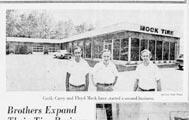
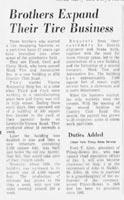
In 1959, enter Tom Beroth.
A neighbor of the Mock brothers, as well as a co-worker at RJ Reynolds, he began helping recap tires in the backyard Mock shop. Thus began a partnership joining the two families. Tom would remain at RJ Reynolds until 1987, as well as working weekends running the concession stands at Bowman Gray Race Stadium. In 1978, with Tom’s help, his son T. would open Stokes Tire after graduating from Guilford College. This was the first offshoot of the Country Club Road store, and the beginning of the expansion of Mock-Beroth Tire and Automotive that has resulted in eleven locations in six counties today.
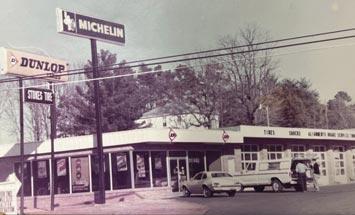


Stokes tire, 1978 Above, L-R: Tom Beroth, who at 90 still advises his grandsons, and the late T. Beroth
Right: Four generations of the Beroth family. Perhaps some of those little ones (and even more born since this photo) will choose to continue the family business. They have an excellent example to follow.
Are you interested in a career with the Mock-Beroth family? They are always looking for potential employees who share their work ethic and high standards for customer service. If you think that you might be a good fit, you can apply on their website.
mockberothtire.com
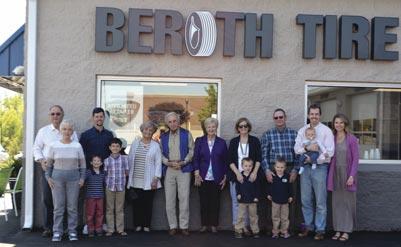
So, that’s the story of how Mock-Beroth Tire & Automotive got started. How have they maintained success?
Both Craig Mock, now retired, and T.J. Beroth, Tom’s grandson and current manager of Stokes tire, credit a couple of things, but primarily customer service. They learned from their grandfather and fathers how to run a business and that relationships matter. They both were taught to always treat people the way that they want to be treated. Craig, now retired, said when he was working day to day, “I always wanted to help people today, in that moment. I wanted to find a way to tell the customer yes.” TJ echoed that, understanding that people do not bring their cars in because they are running great. On a day that they are struggling with transportation, and quite possibly looking at a significant expense, he wants their experience at Mock-Beroth to bring them back.
Those relationships aren’t just for the customers. The Mock and Beroth families know how to treat each other, and their employees. After expanding into Stokes County, other locations around the area were opened. It was always by someone with a close connection-either a relative or a long-time employee. The Mount Airy shop is
Mock-Beroth Tire and Automotive stocks 20,000 tires company-wide, so chances are good that they can meet the needs of their customers. Need something else? They provide automotive services well beyond new tires. Customers even have the convenience of scheduling on-line at mockberothtire.com
managed by Earlie Gilley, another grandson of Tom Beroth. Floyd Mock’s son-in-law, Mike McKnight runs the Robinhood Road location with Carey Mock’s son Bill. There was tremendous growth in the early 1990s through about 2015, but that has since leveled off. There are no plans for a corporate buyout. Just the next generation of two families who value hard work and Christian values. With enough young children among them, hopefully there will be enough Mocks and Beroths to continue the business well into the future.
Trust is another reason for success. T.J. is not interested in one-time customers, but in customers who are satisfied with how they were treated and who repeatedly put their trust in Mock-Beroth. With unusual staff longevity-many employees have thirty years of service or more-customers can feel confident that their vehicle is as safe as it can be. T.J. Beroth knows that their customers are trusting them with not only a significant investment, but the safety of their family. After all, so much is riding on those tires.

Liz McNeely and her husband, Alejandro Merino, are continuing a third generation business tradition established by her grandfather, Bob McNeely, in 1946. He was an owner of Wilson’s Exterminating Company, later known as Wilson’s Pest Control. Her father, Scott McNeely, continued in the pest control business opening McNeely Pest Control in 1999. Liz’s upbringing involved spending a lot of time in nature. She fondly remembers collecting and observing insects for science fair projects with her dad. She spent a lot of time around the business over the years and maintains a close relationship with her father.
Continuing the family business was not Liz’s first plan for a career. A love for adventure and travel led her to Colombia to teach English. Instead of the six months that she signed up for, she ended up staying for eight years. That is where she met Alejandro. Their children, now in elementary school, were both born in Colombia.
While Liz brings pest control knowledge and experience to the business, Alejandro Merino brings business experience, having worked in his family’s businesses previously. He has completed training to work in pest control, and especially enjoys the interaction with their customers. Both he and Liz speak Spanish, which enables them to more easily serve customers.
Liz says that prevention is the key to pest control, so that chemical application is minimized. In addition to conventional control methods, Merino Pest Services offers an environmentally friendly service. Using naturally occuring repellants and organic products, this is safer for humans and pets. It is also a more sustainable method of control since it utilizes natural products and minimizes environmental impacts. Whether you need help controlling insects, termites or mice in your home or business, or mosquitoes, fleas and ticks in your yard, give Merino Pest Services a call!
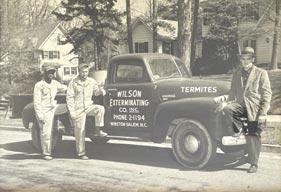
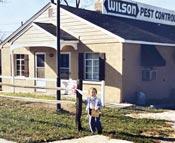
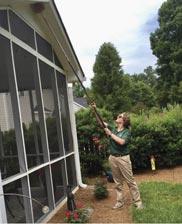
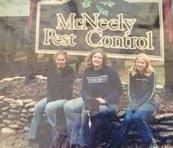
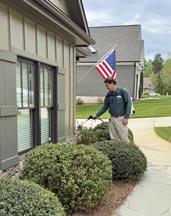









April W. Bowman, Extension Agent, Livestock and Forages
N.C. Cooperative Extension, Stokes County Center
awbowman@ncsu.edu
336-593-8179
https://stokes.ces.ncsu.edu
Facebook: @StokesCountyLivestock
Sheep make a great addition to a small farm. Sheep are grazers, whereas goats are browsers, so they do better on grass, while goats thrive in brushy areas. You can run about two sheep on an acre of land if you are managing it correctly or are supplementing them with hay (dried grass). They are ruminants, which means that their stomach has four different compartments, and it takes roughages, such as grass and hay, to keep all those compartments working properly. The most abundant forage in the Piedmont is Fescue, and most of the time it’s Kentucky 31 Fescue, a type of grass that has a toxic endophyte in the seed heads. The nutrition received from Fescue alone may be enough to maintain a mature sheep that is in maintenance, but it isn’t enough to maintain a lactating ewe or a growing lamb. Plan to supplement your sheep with grain, a protein tub, and/or improved forages. According to the “Planting Guide for Forage Crops in North Carolina”, many of our summer annuals like millet, crabgrass, and teff can be planted in May.
All sheep regardless of their age, or reproductive status need access to a good sheep mineral. Sheep need a small amount of copper in their diets, but too much copper can be toxic so it’s important to feed minerals formulated specifically for sheep.
Sheep have a split in their upper lip which allows them to selectively graze, and to graze much closer than goats (who don’t have a split upper lip). Forages that are grazed shorter than four inches lead to internal parasite problems when we have wet, warm conditions. The parasites (worms) lay eggs that pass to the ground in manure. Those eggs hatch and the larvae crawl up the grass 2-3” where it is consumed by the sheep. Twenty-one days later, the now mature worms lay eggs that start the cycle again. When we can keep our forages 4”, we can usually keep sheep from ingesting the larvae. We can also divide our pastures into sections, and allow each section to rest for 28-30 days to help break the parasite cycle.
Sheep in poor condition, young lambs, and elderly sheep are especially vulnerable to parasites. Parasite resistance is of concern in the livestock industry, especially for small ruminants. Internal parasites are developing resistance to
the few dewormers that are on the market, which limits the availability of options to treat animals. Traditionally, producers were instructed to treat all animals on a given schedule and to rotate dewormers. Research published by the American Consortium for Small Ruminant Parasite Control (wormx.info) dictates that neither is a best management practice. The current recommendation is to treat only the animals that need to be treated, only when they need to be treated, and to continue to use one drug class until it’s no longer effective on your farm. Note: there are only three drug classes, so there aren’t a lot of options. Keep feeding areas clean, and feed hay up off the ground in a feeder.
Before you deworm your sheep, talk to your veterinarian whom you have a Veterinary-Client-Patient-Relationship or VCPR with to seek medical advice or contact your County Extension Livestock Agent for a parasite management plan that can include pasture management, genetic selection, fecal egg counting, and more.
Lamb is the meat of a sheep that is typically less than a year old while meat from older sheep is called mutton. According to Colorado State University, lamb is “an excellent source of protein, vitamins, and minerals, and is especially high in B vitamins, zinc, and iron. Because lamb meat contains significantly less fat compared to other red meats, and has zero carbohydrates, it is a lean and hearthealthy choice. Three ounces of lamb, a typical serving size, covers 43 percent of a male adult’s recommended daily allowance of protein and only seven percent of the recommended daily caloric intake.” The American Lamb Board has hundreds of lamb recipes, which can be sorted by cooking method, or cut of meat. Find those at https://americanlamb.com/recipes/. If you aren’t raising sheep, or don’t want to eat your lambs, take advantage of the free meatsuite.com website to find lamb producers near you.
Sheep manure makes a good fertilizer, but maybe more valuable, it can help increase your soil organic matter, improve water holding capacity, and more. The average analysis for sheep manure is 4–1.4–3.5, or 4 parts Nitrogen, 1.4 units of Phosphorus, and 3.5 parts Potash. According to the University of Wisconsin, if you are applying manure to your vegetable garden, you should apply it four months prior to harvesting any root crops and three months before harvesting other crops due to the risk of E. Coli; thus, fall may be the best time to incorporate it. You can test your compost to determine its fertility, but typically you would apply 40-50 pounds per 100 square feet depending on if it is straight manure or has bedding mixed in with it (https://hort.extension.wisc.edu/articles/using-manure-inthe-home-garden/).
Use caution if feeding purchased hay, or manure from another farmer as some herbicides that grass is treated with have a residual effect. The herbicides can persist on the plant materials. It is important to know the source and chemical history of any green material before it is used in the garden. Learn more in the NC State Extension publication https://content.ces.ncsu.edu/herbicidecarryover. “Farmers should not sell or give away treated hay (even if it is several years old) for use as mulch or for making compost. The hay can be sold for consumption by livestock and horses, but be sure the purchaser is aware that the herbicide may pass through into the manure.”
(Davis, J., Herbicide Carryover in Hay, Manure, Compost, and Grass Clippings).
Wool Vs. Hair
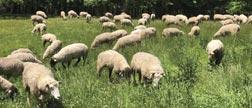
Did you know that not all sheep have wool? There are also sheep with hair. The most common hair breeds are Katahdin, St. Croix, Barbados Blackbelly, and Dorpers. You can tell that they are sheep and not goats not only by their split upper lip but also by the direction that their tail points. Goats’ tails point up (sometimes they hold them closer to their body when they are cold, but the base still goes upwards), while sheep's tails point downward. There are several advantages to hair sheep over wool sheep including no shearing! Hair sheep naturally shed their coats which reduces the time and expense of shearing. Most hair sheep have increased resistance to parasites as compared to wool breeds. Of course, the disadvantage of hair sheep is no wool! Wool can be used for garden bedding to prevent weeds and it adds organic matter. It can be used for spinning, felting, and other crafts. It can also be sold by the whole fleece.
Sheep producers with wool are encouraged to save their wool for the 3rd Annual Piedmont Wool Pool to be held in August (tentatively the 12th). Contact your County Livestock Extension Agent for more information later in the summer. https://www.ces.ncsu.edu/directory/ Summary
Sheep are cute and adorable, regardless if they are hair sheep or wool sheep. North Carolina ranks 30th in the United States in sheep, goats, wool, mohair, and milk. According to the 2022 Census of Agriculture, there is a total number of 36,578 sheep on farms in North Carolina. These numbers represent a 12% increase in sheep numbers, as compared to the 2017 Census of Agriculture. Reach out to me or your County Livestock Extension Agent if you want to add to the sheep population.









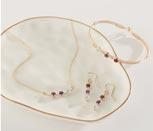

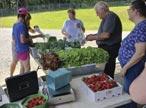


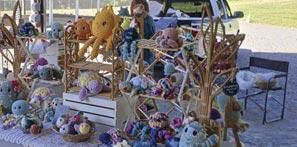
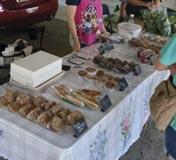
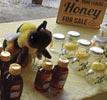
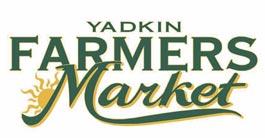

The next two correct entries drawn win a copy of one of our Yadkin Valley Magazine cookbooks.
Enter by postcard, letter or email, be sure to include your: name, PHYSICAL MAILING ADDRESS and guess. And if you’d like, tell us about your experiences using or collecting this item. Entries must be received no later than 6/12/25, Winner will be drawn 6/13/25. The winners will be notified by mail and announced in the July/August 2025 issue. All entries become the property of Yadkin Valley Magazine. Turn to page 90 to read about the March/April contest.
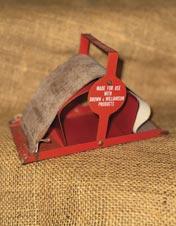
Mail your guess to: “What is That Contest” Yadkin Valley Magazine PO Box 2077 • Yadkinville, NC 27055 or e-mail: yadkinvalleymagazine@gmail.com. You can also enter on-line at: yadkinvalleymagazine.com


Bulova • Hermle
Howard Miller
Why should you buy your new Grandfather Clock from Oldtown Clock Shop & Repair?
Our clocks are under factory warranty and we do the warranty work
We deliver your new clock for FREE
We “set up” your clock in your home or business
We offer a full service department
And even after offering all those extras that others don’t…
Our prices are very competitive!


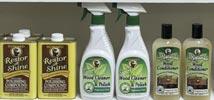


This was a tough one! There were a few correct answers, some close guesses, but overall not as many entries as usual. The March-April What IS That? item is a Gilbarco air pressure meter. According to some YVM readers, these were common at service stations back when the attendant checked the air in the tires while pumping your gas.
Winners for this item are: John Post of Millers Creek was the first drawn for a prize of $100, and a copy of One Last Sweet Bite for the second and third drawn names goes to Kristi Moore of Wilkesboro and Shirley Pitts of Pfafftown. Congratulations!
Please be sure to include your name and physical mailing address with your entries. You cannot be the winner if I don’t know how to send a prize to you!

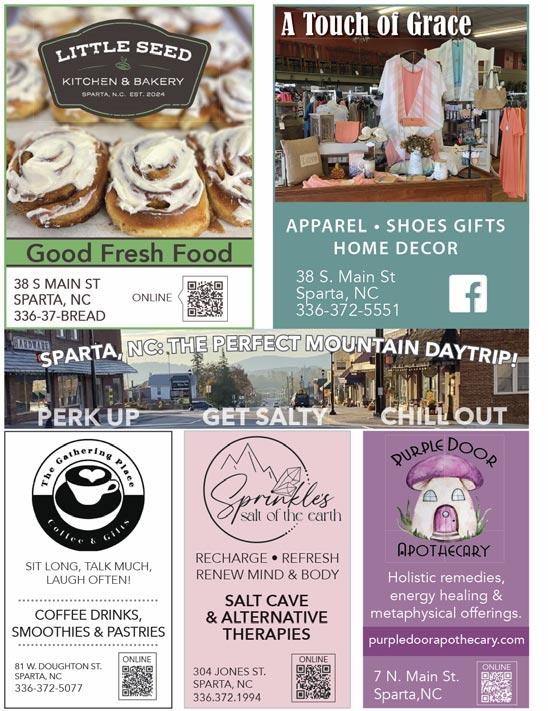

Distribution Counties near Yadkin River in Northwest North Carolina Western Forsyth • Davie • Surry Stokes • Northern Davidson Wilkes • Yadkin (core distribution highlighted) Our next issue: July-August 2025 features.... Yadkin
Deadline for advertising in July-August Magazine is Friday, June 6
If you’d like to learn more about advertising with us contact: Leah Williams 336-961-2620 yadkinvalleymagazine@gmail.com Your advertising message is included in long shelf life print copies plus our digital edition offering with in stores beginning 1st week May

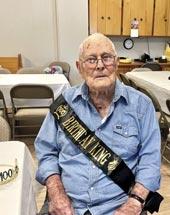
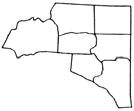
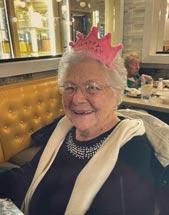
If you know someone who has recently celebrated this milestone birthday, Yadkin Valley Magazine would love to recognize them. Send in their name and a photo by June 1 to see them in the July/August issue. Photos mailed in will not be returned, so please send a copy. 100th Birthday









Marriage is more than a ceremony — it’s a union of families and finances. When you and your partner are honest with each other about money and financial goals, it can help build trust, leverage your strengths and help pave the way for a financial happily ever after.
Since talking about money can be difficult, begin with conversations not so much about money itself but about the things that matter to you. You’ll find these are also your financial priorities and a good way to see if you’re on the same page, or how far apart you might be.
Here are a few conversation starters:
•Make a list of short- and long-term goals — from buying a house to retiring early. Do you want children? Will one of you change careers or go back to school? See where your lists overlap and where some goals may be more important to one partner.
•Ease into the financial implications. If you plan to grow your family, would one of you like to stop working or reduce your hours to provide child care? If more schooling is a priority, what kinds of changes might that require?
•Share your feelings about money. How did your family treat money while you were growing up? What does money mean to you — security, freedom, stress or something else? Are you both spenders or savers, or is there one of each?
Before your big day, or early in your marriage, decide how you’ll blend your financial lives:
•Fully disclose your current financial situation. Discuss each partner’s assets and debts and how, or if, you’ll combine them. There’s no one right answer — the key is for you both to agree. In nine community property states, all assets and debts are shared 50/50 after marriage regardless of individual or joint account status. Check to see whether yours is one of them.
•Align on your budget and spending. This can empower you to spend within your means while moving toward your financial goals.
•Determine who will handle the various tasks of managing money. Who is responsible for which bills, who files the taxes and when will you consult each other on financial decisions like major purchases — a car, perhaps, or a major household appliance?
Once you're married, there are a few things to address right away. You may want to consult with financial, tax and legal professionals to help avoid pitfalls and identify opportunities:
•Employer benefits. Newly married employees usually have a 30-day special enrollment period to update certain benefit elections — such as health and life insurance.
•Adjust the W-4 tax withholding on your employee forms to reflect your marital status and ask your tax professional which tax-filing status makes sense for you.
•Insurance policies. Combine and update policies and beneficiaries, including adding each other to auto insurance policies if you drive each other’s cars.
•Estate documents. Now with a family, prepare for the unexpected. Create or update a will, medical directive, and financial and health care powers of attorney, and you may want to explore whether a revocable trust is appropriate. Getting married is perhaps one of the most exciting times of your life. As you commit to a lifetime together, make sure that includes a financial commitment. By starting a habit of financial discussions now and returning to them periodically, you can help set yourselves up for a lifetime of financial compatibility, stability and freedom.
This article was written by Edward Jones for use by your local Edward Jones Financial Advisor.

Paul J. Bunke, Sr., AAMS™, CFP®
Financial Advisor
124 W. Kapp Street, Suite C PO Box 407 Dobson, NC 27017
336-386-0846
paul.bunke@edwardjones.com
Audra Cox, ABFP ™
Financial Advisor
715 S Main St, Suite B Dobson, NC 27017
336-569-7385 • 844-795-3462
audra.cox@edwardjones.com
Frank H. Beals
Financial Advisor 965 North Bridge Street Elkin, NC 28621
336-835-4411
frank.beals@edwardjones.com
Timothy Johnson
Financial Advisor
116 E. Market St. Elkin, NC 28621
336-835-1124
timothy.johnson@edwardjones.com
Nathan Sturgill
Financial Advisor
116 E Market Street
Elkin, NC 28621
336-835-1124
nathan.sturgill@edwardjones.com
Aaron L. Misenheimer, CFP®, ChFC®
Financial Advisor
1530 NC Hwy 67, Suite A
Jonesville, NC 28642
336-258-2821
aaron.misenheimer@edwardjones.com
Andi Draughn Schnuck
Financial Advisor
496 N. Main Street Mount Airy, NC 27030
336-789-1707
andi.schnuck@edwardjones.com
Dale Draughn, AAMS™
Financial Advisor
140 Franklin Street Mount Airy, NC 27030
336-789-0136
dale.draughn@edwardjones.com
Logan Draughn
Financial Advisor
492 N. Main Street Mount Airy, NC 27030
336-789-3323
logan.draughn@edwardjones.com
Kody Easter, AAMS™, CRPC™, CFP®
Financial Advisor
304 East Independence Blvd Mount Airy, NC 27030
336-789-2079
kody.easter@edwardjones.com
Randy D. Joyce
Financial Advisor
136 W. Lebanon Street Mount Airy, NC 27030
336-789-6238
randy.joyce@edwardjones.com

Tammy H. Joyce, AAMS™ Financial Advisor
136 W. Lebanon Street, Mount Airy, NC 27030
336-789-6238
tammy.joyce@edwardjones.com
Tanner Joyce
Financial Advisor
752 S. Andy Griffith Pkwy, Suite 400 Mount Airy, NC 27030
336-245-9112
tanner.joyce@edwardjones.com
Mike Russell
Financial Advisor
106-B South Depot Street, Pilot Mountain, NC 27041 336-368-2575
mike.t.russell@edwardjones.com
Tiffany L. Smith
106-B South Depot Stree Pilot Mountain, NC 27041 336-368-2575
tiffany.l.smith@edwardjones.com
Michael Warren, WMCP®
Financial Advisor
101-D Shoals Road, Pilot Mountain, NC 27041
336-368-0782
michael.warren@edwardjones.com
Christopher L. Funk
Financial Advisor
128 South State Street • PO Box 790 Yadkinville, NC 27055 • 336-679-2192
chris.funk@edwardjones.com



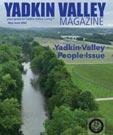


If you are concerned about the safety of your packages delivered to your house, you can give Amazon an electronic key to your house and garage. This service is called Amazon Key. With this service, instead of delivering your packages to your front porch, the Amazon delivery person will put your packages in your garage or inside your house. The ad for this service shows people relieved that their Amazon package is not outside where it could be stolen but safely in their garage. Think with me for a minute about what this is saying. It says that we trust a multinational corporation more than we trust our neighbors.
This is the world many of us live in. I am very lucky that I have great neighbors. One neighbor walks her dog by my house and will pick up my package if she knows I am out of town. Another neighbor sent me a message when she saw a strange man wandering around my backyard. It turned out to be a contractor working on my house, but I appreciated her looking out for me. Another neighbor sits on their front porch most of the day and night. They see everything that goes on in our neighborhood and will speak up if they see anything suspicious. I feel safer knowing that I have neighbors who care and are watching out for me.
This isn’t the case for everyone. Whether you live in a neighborhood with houses side by side or you live on a country road with the houses spread out, I wonder how many of your neighbors do you know well? We often quote that Jesus tells us in Scripture, “love your neighbor.” That Scripture is often used to encourage us to love someone living on the other side of town who needs help or to love someone on the other side of the world. Loving strangers, who we will never meet, is easy. But imagine for a moment, what if Jesus meant your literal neighbor, the eight houses that are closest to yours? How well do you love your neighbor if that was the measurement?
Loving your literal neighbor begins with knowing their names. How can you love someone if you don’t know them? It can be intimidating to meet your neighbor, especially if they have lived near you for a long time. The journey of knowing your neighbor continues by knowing what is important to them and looking for ways to help them. The only way to do that is to talk with them. I know that is really hard and there are many good reasons why we don’t talk to each other anymore – we are too busy, we spend our lives inside all the time, we don’t trust each other, or we are living beside people different from us. On the other hand, those are all the reasons why we would really benefit from talking to them.
Jay Pathan and Dave Runyon wrote a great book about getting to know our neighbors – The Art of Neighboring. They share in this book how amazing things emerged when they slowed down the busyness of their lives as ministers and took the time to get to know their neighbors.
They encourage all of us to slow down and deliberately invite our neighbors into a friendship. We live in a time when more people are very lonely. The Surgeon General even wrote a report in 2023 on the epidemic of loneliness and isolation. He explains in this report that loneliness “harms both individual and societal health. It is associated with a greater risk of cardiovascular disease, dementia, stroke, depression, anxiety, and premature death.” Getting to know your neighbor could help you live longer and live better!
Imagine all the unexpected connections that can be made when you get to know your neighbor. You may love to bake and you could share this love with a lonely neighbor. You may have a neighbor who loves to garden but doesn’t have the space to build a garden. Perhaps you have an old garden bed that you struggle to keep up. What if you invited your neighbor to use some of your land to plant vegetables this summer? Imagine if you need a new ladder to reach a certain area of your house. What if you asked your neighbor to borrow a ladder instead of going to Lowe’s and buying a new one. Imagine if you offer to mow your neighbor’s yard and in return they watch your pets when you go out of town. The possibilities of how we can help each other and how our lives can be made richer, if we took the time to love our neighbors well, are endless. How well do you know your neighbors? Reach out to me if you would like to learn more about a small group study with practical applications to help the members of your church get to know their neighbors better. It will help you follow Jesus' call to love your neighbors literally and seriously. Imagine the world we could build together, starting simply with the people right outside our front door.
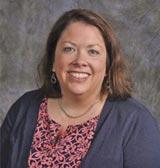
Rev. Dr. Heather Kilbourne spends her days helping rural churches dream God-sized dreams for their communities. She is the founder and Director of Faith in Rural Communities at the NC Rural Center. She is an ordained minister in the United Methodist Church and served churches in Yadkin and Burke Counties. She can be reached at hkilbourne@ncruralcenter.org.
Care South, Inc. is a locally owned and respected agency that has provided more than 20 years of In-Home Aide Care to individuals who require assistance with Activities of Daily Living (ADLs).



To inquire about services for you or a family member or employment opportunities for:
In-Home Aides, Certified Nursing Assistants (C.N.A), and Personal Care Assistants (P.C.A), please contact us at:
Mission
To deliver exceptional Personal Care Services (PCS), allowing the client to live safely and comfortably in their own home and to provide leadership in which employees have faith and confidence.
What Programs are Provided through the Agency?
• Community Alternative Program for adults (CAP/DA)
• Personal Care Services (PCS)
• Veterans Administration (VA)
• Temporary or Long-term Care
• Chore Respite
• Private pay
Summary of the Service Provided:
• Activities of Daily Living (ADLs) (i.e., eating, bathing, dressing, toileting, mobility, and grooming)
• Instrumental Activities of Daily Living (iADLs) (i.e., light housekeeping, meal prep)
Practices and Staff:
• Licensed and bonded in North Carolina.
• RN Supervisor conducts quarterly visits to the home.
• CPR Instructor
• Staffing Coordinators provide 24/7 On-Call Services.
• Caregivers complete monthly in-services, maintain C.P.R., and perform skills competency verification by the R.N.
• Comprehensive background investigation of all caregivers (i.e., criminal background)
• Quality Assurance Program

512 N. Bridge Street,






